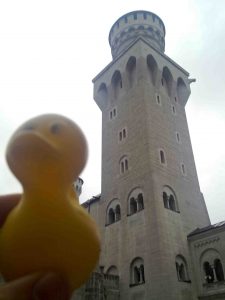 I suggest to play this March Music to add more atmosphere while reading this blog.
I suggest to play this March Music to add more atmosphere while reading this blog.
Update 08.2019: Wiggerl is now joining the swam.

A disputed document of Aventin (1477-1534) mentions castle “Schyren about 50 km north of Munich as a former rulers residenz of the rulers of that area (since 508). The Counts of Scheyern later moved away their residence from “Scheyern” to castle “Wittelsbach” and renamed themselves “Wittelsbacher”.
Other sources connect the “Wittelsbacher” with the “Luitpoldinger” or even with “Karl the Great” (Charlemagne) or even with “Troy” (with ancestor Aeneas who also came through Butrint Albania.
Scheyern
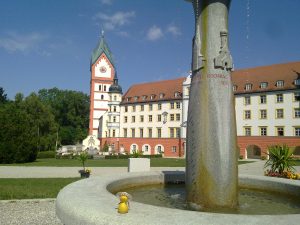
Abandoned Castle Scheyern was turned into a monastery by Count Otto V. 1119 which served as burial site of the “Wittelsbacher” until 1253. Since 1180 the church hosts the relict “Scheyrer Kreuz”. Duke Otto I., the first Wittelsbacher Duke (1117-1183) 1180 followed “Heinrich der Löwe” after Heinrich, a mighty “Welfe” (ruler in Saxony) let down his cousin emperor “Friedrich Barbarossa” in one of his wars in Italy after he supported him for a long time without getting enough reward. Duke Otto I. had been faithfull and got his reward. He bravely fought for Barbarossa in the battle at the Veronesa Klause in Italy and saved Barbarossas skin. This started the Wittelsbacher rule 1180 in Bavaria. Otto is interred in Scheyern. There are also two statues of Otto in Munich: in the “Hofgarten” and on the “Wittelsbacher Brücke” (bridge).
It is a surprise that the Wittelsbacher only provided for three German kings (two emperors) and that the Habsburger Dynasty was much more successful on that ground. But the Habsburger, not mentioned in the „Golden Bull of 1356“ with the „Privilegium Maius“ and Erzherzog Rudolf IV. were the cleverer counterfeiter when it really counted 1358/1359. The title „Erzherzog“ is a heritage of that event. And they are also big liers as Habsburger emperor Ferdinand I. Erzherzog of Austria’s motto was: „Fiat iustitia, et pereat mundus“ (let there be justice even if the world perishes).
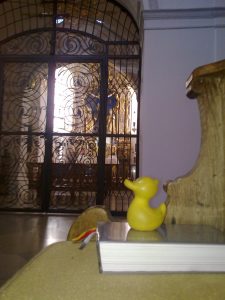
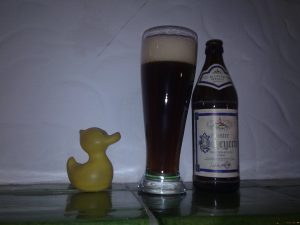 in front of the “Hl. Kreuzkapelle” (chapel where the Relic of the Holy Cross is kept) and the beer of the monastery.
in front of the “Hl. Kreuzkapelle” (chapel where the Relic of the Holy Cross is kept) and the beer of the monastery.
In the “Königskapelle” (royal chapel), also part of the complex 995/996 King (therefore royal chapel) Stephan from Hungary is said to have been engaged with Gisela, a sister of emperor Heinrich II., the last “Ottone” who is interred in the Cathedral in “Bamberg“.
Hofgarten Otto I.
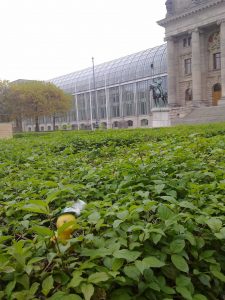
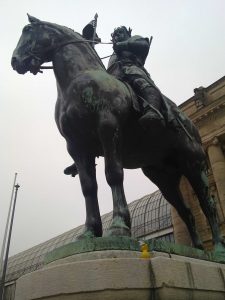
In the “Hofgarten” in front of the “Staatskanzlei” (initiated by Franz Josef Strauß, criticized for its size bigger than the White House called “Straußoleum“, finished by Max Streibl, containing the expensive “Zirbelstüberl„; Zirbe is special rare tree whose oily odor is very healthy ; or as insider call the room the “Amigostüberl”) and Sheila at Duke Otto I. equestrian statue. There is another one on the Wittelsbacherbrücke in Munich.
1119 Earl Otto V. of Scheyern moved from Scheyern to the castle “Wittelsbach” and from 1120 on the earls called themselves “Pfalzgrafen von Wittelsbach”. But they were not lucky there and did not stay for long. Pfalzgraf Otto VIII. von Wittelsbach had to leave after German King Phillip von Schwaben (a Staufer) broke his promise of 1203 to later bewed one of his 4 daughters “Kunigunde” (one year old at the time of the promise) to Otto VIII. Instead Phillip 1207 agreed to engage her with the more promising 2 year old son of Bohemian King Ottokar I. During another wedding celebration of a niece of Phillip in Bamberg count Otto VIII. took revenge and killed Phillip with his sword wich left only one remaining legitimized male, still very young Staufer heir, the nephew of Phillip and grandson of “Friedrich I., Barbarossa” , later German King “Friedrich II.” Wittelsbacher Otto VIII. was captured 1209 by the men of Welfe Otto close to “Kehlheim” in “Oberndorf”, beheaded right on the spot, his head thrown in the “Danube” river and his body put into a barrel for several years. It took a while until the body was decently burried by some monks. It does not always help to be a ruler, not if you kill a more powerfull ruler. Count Otto VIII. was a nephew of Duke Otto I. and a cousin of Duke “Ludwig der Kehlheimer”. Castle Wittelsbach was torn down in the following and left by the Wittelsbacher. But they kept the name. Only a church remained, unfortunately under a scaffolding while Sheila was there. Fortunately a lot of the event had been blamed in time (unjustified as later proofen) on the noble family “Andechs-Merander” as the bishop “Ekbert” of Bamberg at that time was from the mighty family “Andechs-Meraner” and the groom “Duke Otto VII” from “Andechs-Meran” was as well. That was a distinct setback for the Andechs-Meraner and a big progress for the Wittelsbacher who showed a lot of their pragmatism. After first Welfe Otto became the next emperor and than Friedrich II. the Staufer the Wittelsbacher Ludwig der Kehlheimer always knew which side his bread was buttered on and changed sides in time.
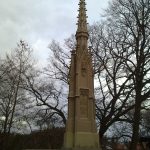
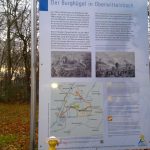
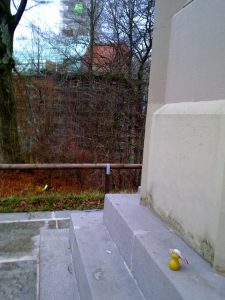
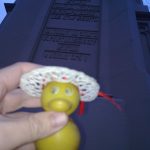
The Wittelsbacher avoided to visit the castle hill of Wittelsbach for the next 6 centuries. Even during the opening ceremony of a memorial under the reign of King Ludwig I. the king did not come even though he is mentioned on the memorial. Later King Maximilian II. visited the place 1857. Iconic “Sissi” (cousin of Ludwig II. and empress of Austria, Queen of Hungaria spent part of her childhood in the nearby “Sissi Schloß” castle and there is a hiking trail to this place.

Landshut
“Ludwig der Kehlheimer” was born 1173 in Kelheim and followed his father as Duke when he was only 10 years old. He was a true allied subject of emperor Heinrich VI. , a Staufer. Ludwig founded the important cities “Landshut”, “Straubing” and “Landau”. “Ludwig der Kehlheimer” is called the “Kehlheimer because he was murdered in “Kehlheim” on a bridge while he was on a walk 1231. The old bridge over parts of the Danube is no longer there but his son and heir “Otto the Illustrious” changed the gate of the bridge into a memorial chapel “Ottokapelle“. Ludwig ist interred in Monastery Scheyern.
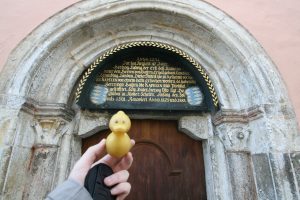
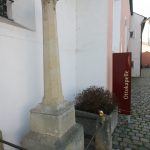
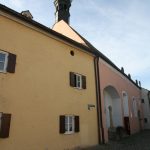
Heidelberg
A statue of Ludwig the Kehlheimer is visible on the facade of the Heidelberger castle. The Pfälzer Palatine Residence of the Wittelsbacher. (left)
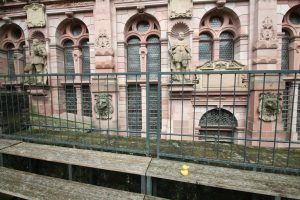
Ludwig der Kehlheimer founded several important cities in Bavaria, such as Landshut 1204 with Castle Trausnitz,
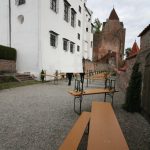
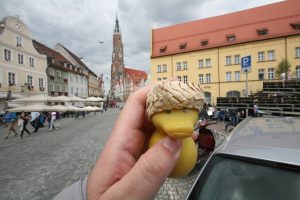
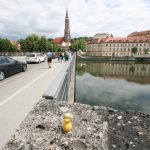
(The Wittelsbacher princes kept wild animals in the trenches of the castle such as crocodiles which, surprise, however did not live for long due to the temperatures in lower Bavaria). The Center / Old town is one of the best maintained mediaeval towns in Germany with many gothical and renaissance buildings and memorials and a world cultural heritage. Castle Trausnitz contains excellent wall carpets with historic scenes of the Wittelsbacher history.
Landshut is well known for it’s „Landshuter Hochzeit“ (wedding) which is commemorated with a Renaissance Festival.
Duke Ludwig the Kehlheimer married his second wife Ludmilla von Böhmen the widow of count Albert III. von Bogen after they went to war against each other. Though Ludwig lost against the Count of Bogen and allied Andechs-Meran, emperor Heinrich VI. decided in favor of the Wittelsbacher. After Albert III. ’s son Albert IV. died early , Ludwig was able to claim the heritage of the counts of Bogen for his Wittelsbacher son Otto der Erlauchte. This is how the lozenge pattern became part of the Wittelsbacher colours.
Landau
Ludwig also founded Landau an der Isar 1224 at a slope on the side of the Isar valley with the splendid baroque St. Mariä Himmelfahrt church 1713. In the same year the black plague was raging in the city. Facing the church, there used to be the Castle of the Wittelbacher Dukes but it ain’t there, at least Sheila could not find it. We did see a „Hofgartenstraße“ (court garden street) but no garden is left. St. Sebastian is commemorated in the church and there is a Sebastian/- fountain and place in the lower part of the town and Sheila and I shared an ice cream and coffee there. Also in the church as statue of Jesuit Ignatius von Loyola, the Wittelsbacher supported and promoted the Jesuiten. (also s. St. Michael in Munich, Abrecht V.) And it possesses a splinter of the cross Jesus Christ is said to have been crucified on.
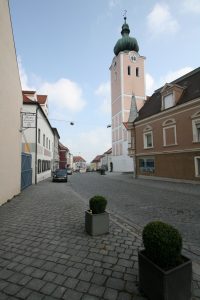
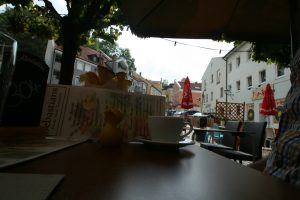
St. Mariä Church and the Sebastian-Place; in the Sebastian coffee shop, fountain covered by menu. (also s. Richard Strauß ….., he spent his holidays in the house)
and Straubinger Neustadt.
1255 Wittelsbacher Duke Ludwig II. (der Strenge) converted an even older castle in Munich, Germany, Bavaria to his residence. One son of Ludwig II., later Emperor Ludwig the Bavarian (Ludwig IV.), also had his Bavarian residence in the old court (“Alter Hof”). According to legends Duke Ludwig II. possessed a monkey as a pet which kidnapped baby Ludwig (the later emperor). The monkey was chased through the castle and climbed up on the roof with the baby over the wooden bay of the castle. After a while and some discomfort for the staff the monkey climbed back down and laid the baby back into his bed. The little tower is called monkey tower because of that.
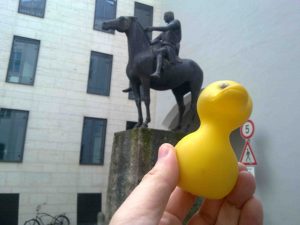
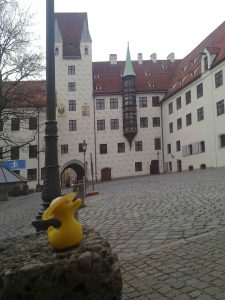
Sheila in the Old Court in Munich with the monkey tower. In front of the back entrance there is a memorial of Emperor Ludwig IV. the Bavarian.
A memorial sign tells about the facts. “Ludwig der Strenge” (the rigorous) received his nickname after he killed his first wife “Maria von Brabant” as he wrongly believed she had been unfaithful to him. Or maybe he was hoping to with Anna von Glogau, find a better, richer match after the event.
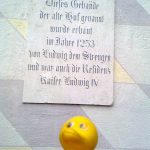
Thanks to a rare special tour Luck Duck Sheila could visit the attic of the “Alten Hof”. While some of the younger parts of the woodwork of the roof were destroyed in World War II. fortunately the oldest parts which date back to the early 15’th century still remain and are some of the oldest roofs in Munich.
Sheila could enjoy a nice view overlooking Munich and into the top of the monkey tower. There are documents (bills), which proof that monkeys have been kept in the attic and that windows had to be repaired because they were broken by the monkeys.
The view overlooking the city and Sheila in front of the top of the “Monkey Tower”
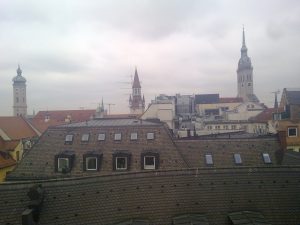

Fürstenfeldbruck
“Ludwig der Strenge” paid for the murder by founding “Monastery Fürstenfeld”. (1258) Sheila thinks it’s great to be a ruler. “Ludwig der Strenge” who was born and died in Heidelberg is interred in the tomb here. And it’s said also the heart of Emperor “Ludwig der Bayer” (“der Bayer” was originally but is no longer a foul name because of conflicts with the Pope and other rulers from the Luxemburger and Habsburger side). The emperor died during a hunting excursion close by. Later pope Benedikt XVI. said a mass here 1978 according to a sign at the churches door. The church was completed in Baroque stile as the new “Bavarian Escorial” (by elector Max Emanuel), one of the most grand Baroque churches, for sure the most beautiful baroque church of the country (Michael Hartig) .
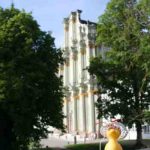
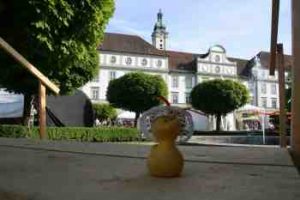
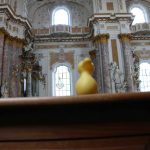
From 1923 -51 monastery “Kloster Ettal” leased this monastery.
Grünwald
 Ludwig der Strenge also bought”Castle Grünwald”
Ludwig der Strenge also bought”Castle Grünwald”  which was later redecorated by Duke Albrecht IV. It was used as a save heaven during times of the Black Plague, served as residence of Margarethe, the widow of emperor Ludwig der Bayer and prison. The Castle appears in this Video.
which was later redecorated by Duke Albrecht IV. It was used as a save heaven during times of the Black Plague, served as residence of Margarethe, the widow of emperor Ludwig der Bayer and prison. The Castle appears in this Video.
Emperor Ludwig IV. who was (and still is) excommunicated after territorial conflicts with the Pope and Pope promoter Luxembourger Karl IV. is interred in Munich’s Frauenkirche.
Frauendom
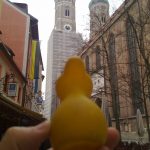
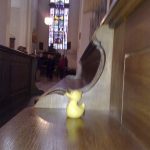
 Tomb of Ludwig der Bayer
Tomb of Ludwig der Bayer
Sheila in front of the Frauenkirche (Frauendom)
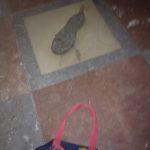 And the mysterious footprint of the devil in the entrance hall of the Frauendom. Ludwig der Bayer received the Emperors crown in Rom, Italy but as the only early Emperor not from a pope. That was after conflicts and war with Habsburger Friedrich der Schöne (Friedrich the beautiful), who was overcome 1313 in the battle of Ampfing? Gammelsdorf? Mühldorf ? (the exact spot is unclear, the last big ballet like battle without firearms, some sources say that Ludwig did not act too knightly). Friedrich der Schöne was caught and arrested in the Castle Trausnitz in Landshut, released after his promise to cooperate with Ludwig and to bring even more of his allies on Ludwigs side. After those allies did not cooperate, he returned to the prison to keep his oath.
And the mysterious footprint of the devil in the entrance hall of the Frauendom. Ludwig der Bayer received the Emperors crown in Rom, Italy but as the only early Emperor not from a pope. That was after conflicts and war with Habsburger Friedrich der Schöne (Friedrich the beautiful), who was overcome 1313 in the battle of Ampfing? Gammelsdorf? Mühldorf ? (the exact spot is unclear, the last big ballet like battle without firearms, some sources say that Ludwig did not act too knightly). Friedrich der Schöne was caught and arrested in the Castle Trausnitz in Landshut, released after his promise to cooperate with Ludwig and to bring even more of his allies on Ludwigs side. After those allies did not cooperate, he returned to the prison to keep his oath.
Ludwig der Bayern died 1347 during a hunting excursion at “Puch” close to Fürstenfeldbruck, hit by a sudden stoke in the arms of a farmer. A memorial points out the place and event.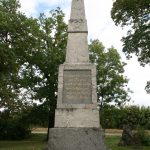
The tombstone in the Frauendom lying under the redecorated roof memorial which was created by “Kurfürst Maximilian I.” shows the emperor on a throne in heaven and a reconciliation scene of Duke Ernst and his son Albrecht III. Ernst killed Albrechts wife, daughter of a barber Agnes Bernauer.
Pfalzgrafenstein
Ludwig der Bayer possessed some very profitable castles/toll stations such as at the Rhine River in the Pfalz, such as the striking castle Pfalzgrafenstein in the middle of the Rhine river. (Freistaat Flaschenhals) Sheila says a Knight is a Robber Knight with a title.
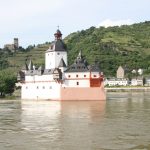
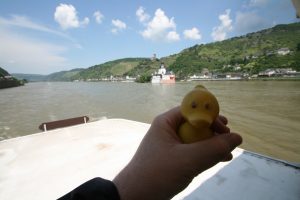
The “Isartor” was built under “Ludwig the Bayer” as the city of Munich was enlarged after ab big fire 1327 and a new outer wall was built 1285-1347. The Isartor was finished 1337 and it is the only gate which is almost completely preserved. It was the main gate for the “Salzstraße” (Salt Street from “Bad Reichenhall“) King Ludwig I. rehistorised the gate 1833 just like the Bamberger Dom. The gate was severely damaged in WWII. but repaired later. Since a couple of years the court of the gate hosts the biggest brandy punch pot worldwide and the drink is served there at Christmas time. Of course Sheila had to take a swig or two and she enjoyed it a lot.
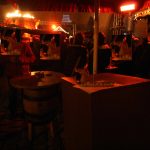
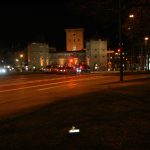
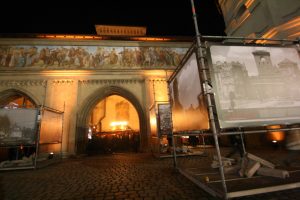
Bamberg
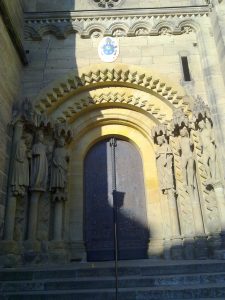
Bad Reichenhall
It was the salt of the Saline “Bad Reichenhall” and the Salt mine of Berchtesgaden (oldest operating salt mine in Germany) which entered the city of Munich through that gate. From 1594-1723 the mine itselves became a good source of income for the Wittelsbacher Cologne Archbishops who controlled the mine at that time. The salt mine can be visited but taking pictures inside is not allowed. It is still an operating successfull salt mine. Sheila consumes their good salt every day. She in the mine for short saw a memorial plate for Wittelsbacher Karl Theodor, the interesting tour unfortunately hurries through the mine as it has many visitors. Erasmus Grasser, artist, sculptorer and engineer enclosing the spring of the Saltmine in Reichehall. One of his master-pieces is in the Church St. Maria Ramersdorf.

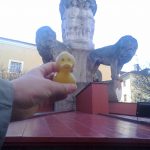
Salt mine in Berchtesgaden and “Alte Saline, Bad Reichenhall” Bad Reichenhall, and Wittelbacher Säule (column)
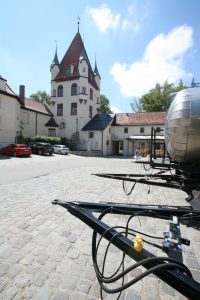 Another son of Ludwig II. the rigorous and his wife Mathilde of Habsburg (daughter of Rudolf of Habsburg who is interred in Cathedral Speyer) was Rudolf I. of the Pfalz , also called “Rudolf der Stammler” (the Stammerer). Rudolf 1292 built castle Kaltenberg but the castle was lost soon later by the Wittelsbacher due to some local conflicts and had numerous owners during the next 7 centuries. Rudolf is the ancestor of the Pfälzer branch of the Wittelsbacher. The castle Kaltenberg came back into the possession of the Wittelsbacher Dynasty 1954 when the house Wittelsbach bought the castle and compound. Prince Luitpold of Bavaria started a famous renaissance festival here 1979 with knights tournaments “Kaltenberger Ritterturnier”.
Another son of Ludwig II. the rigorous and his wife Mathilde of Habsburg (daughter of Rudolf of Habsburg who is interred in Cathedral Speyer) was Rudolf I. of the Pfalz , also called “Rudolf der Stammler” (the Stammerer). Rudolf 1292 built castle Kaltenberg but the castle was lost soon later by the Wittelsbacher due to some local conflicts and had numerous owners during the next 7 centuries. Rudolf is the ancestor of the Pfälzer branch of the Wittelsbacher. The castle Kaltenberg came back into the possession of the Wittelsbacher Dynasty 1954 when the house Wittelsbach bought the castle and compound. Prince Luitpold of Bavaria started a famous renaissance festival here 1979 with knights tournaments “Kaltenberger Ritterturnier”.
And he also brewes the excellent White Beer “König Ludwig Dunkel” here and continues the Wittelsbacher tradition of beer brewers. 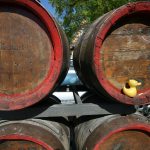

The brothers Rudolf I. and Ludwig der Bayer had several arguments and were at several wars against each other and later Ruprecht of the Pfalz I. respectively his Habsburger mother, son of Rudolf I., later made an agreement 1329 „Hausvertrag von Pavia“ which led to the separation into two major dynastical lines of the Wittelsbacher. (Pfalz for Ruprecht, Bavaria for Ludwig, which reunited not sooner than in the late 18′ th century)
1360 a son of Emperor Ludwig gave the “St. Maria Church” in Ramersdorf (independent village at that time) a relic, a splinter of the cross Jesus was said to have been crusified on (one of the many if you consider the amount of splinters all over the world), built in a silver cross. 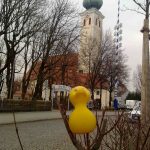 Emperor Ludwig IV. received the silver cross in Rom from Counterpope Nikolaus V. And Ludwig is said to have been carrying it on a chain round his neck. Before becoming Pope Nikolaus V. was married for 5 years and later had to retreat 1330 and subject to the Pope John XXII residing in Avignon, France. The church has been rebuilt and finally completed in Baroque stile several times and received a lot of attention by many nobles. During pilgrimage time (15. August to 14. September) a special pastry is sold and served in the neighboring bakery “Huber”. “Zwetschgenbavesen” (based on plumbs) Update: July 2014: the bakery closed down after more than 150 years in business. What a pity. Next to the church a typical Bavarian Maypole.
Emperor Ludwig IV. received the silver cross in Rom from Counterpope Nikolaus V. And Ludwig is said to have been carrying it on a chain round his neck. Before becoming Pope Nikolaus V. was married for 5 years and later had to retreat 1330 and subject to the Pope John XXII residing in Avignon, France. The church has been rebuilt and finally completed in Baroque stile several times and received a lot of attention by many nobles. During pilgrimage time (15. August to 14. September) a special pastry is sold and served in the neighboring bakery “Huber”. “Zwetschgenbavesen” (based on plumbs) Update: July 2014: the bakery closed down after more than 150 years in business. What a pity. Next to the church a typical Bavarian Maypole.
1330 Emperor Ludwig after he returned from wars in Italy founded Monastery Ettal.
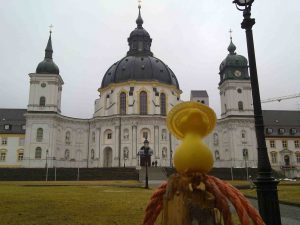 (“Kloster Ettal”). The monastery was later completed in Baroque stile and is an important pilgrimage site. An old Romanic tower (above Sheilas head) is still preserved. Emperor Ludwig gave the monastery a small statue called “Ettaler Madonna” which he brought from Italy. The statue in an event that caused a little sensation was stolen and mysteriously reappeared in the late 1980’s. Astonishing few information about that event can be found in the internet.
(“Kloster Ettal”). The monastery was later completed in Baroque stile and is an important pilgrimage site. An old Romanic tower (above Sheilas head) is still preserved. Emperor Ludwig gave the monastery a small statue called “Ettaler Madonna” which he brought from Italy. The statue in an event that caused a little sensation was stolen and mysteriously reappeared in the late 1980’s. Astonishing few information about that event can be found in the internet.
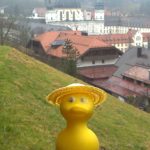
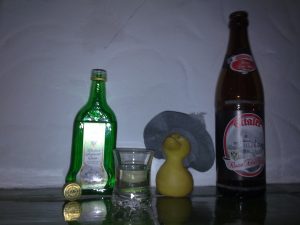 Ettal produces beer and liquer in Ettal, but also in Hessen but with the original recipe.
Ettal produces beer and liquer in Ettal, but also in Hessen but with the original recipe.
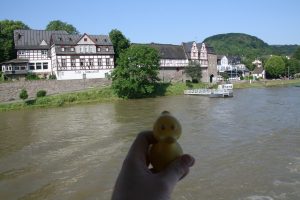 German King Ruprecht III. of the Pfalz (Wittelsbacher 1352-1410) was nominated German king on the “Königstuhl” 1410 at the Rhine Oberlahnstein (not the mountain at Heidelberg with the same name). He was elected king as the only German king with his own vote. This interrupted the Luxembourger reign and of the related Habsburger by a Wittelsbacher for the second time.
German King Ruprecht III. of the Pfalz (Wittelsbacher 1352-1410) was nominated German king on the “Königstuhl” 1410 at the Rhine Oberlahnstein (not the mountain at Heidelberg with the same name). He was elected king as the only German king with his own vote. This interrupted the Luxembourger reign and of the related Habsburger by a Wittelsbacher for the second time.
Andechs
Dießen
Pious Duke Albrecht III. 1455 founded the Benedictine Monastery “Andechs” where he is interred. 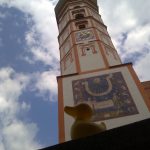 After the former Counts of the family “Andechs-Meraner” did not leave male successors Albrecht III. took over the place and founded the monastery on the remains of the former castle on the “Holy Mountain” as the place is called in the area. It is also one contemporary burial-site of the Wittelsbacher Family. The town of Dießen on the other side of the Ammersee was also taken over by the Wittelsbacher from the Andechs Meraner 1248.
After the former Counts of the family “Andechs-Meraner” did not leave male successors Albrecht III. took over the place and founded the monastery on the remains of the former castle on the “Holy Mountain” as the place is called in the area. It is also one contemporary burial-site of the Wittelsbacher Family. The town of Dießen on the other side of the Ammersee was also taken over by the Wittelsbacher from the Andechs Meraner 1248.
The Marienmünster in Dießen was built in the years 1732-1739.
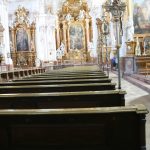
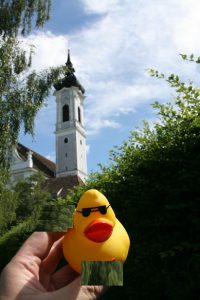
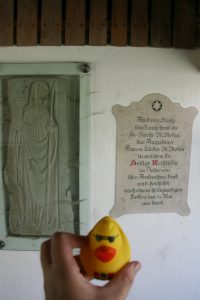 The Marienmünster contains relics of Holy Mechthild von Dießen (1125-1160) who helps against lightning and headache. Duck Clemens August whom I picked up in the „Kölner Dom“ and who joins the team since then had a good time here.
The Marienmünster contains relics of Holy Mechthild von Dießen (1125-1160) who helps against lightning and headache. Duck Clemens August whom I picked up in the „Kölner Dom“ and who joins the team since then had a good time here.
Blutenburg
As his father “Duke Ernst” let his due to some sources undoubtly bewedded wife “Agnes Benauer” (inadequate connection as she was “only” daughter of a barber from the city of Augsburg) being drowned in the Danube (“Donau”) river at “Straubing” Albrecht III. almost went to war against his father but later reconsiliated. Agner Bernauer for a short time lived in the Water-Castle Blutenburg and there is a memorial which tells about her story. There is a rare, very nicely decorated small gothic church from the late 15’th century.
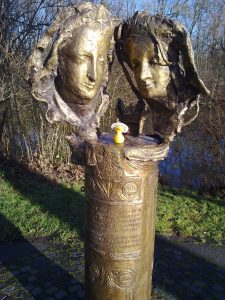
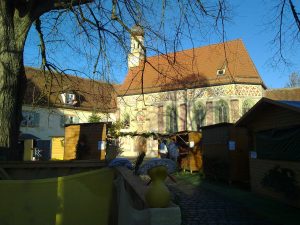
Sheila in front of the water castle “Blutenburg”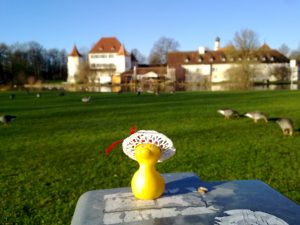
Blutenburg was again in the catch-line then Lola Montez , Countess of Landsfeld (see King Ludwig I. further down) stayed here for the night then she had to flee from Munich to Switzerland after the Revolution of 1848. It was again in the catch-line after the famous Blutenburger Madonna sculpture originating from Erasmus Grasser’s circles was stolen 1971 and baught by famous actor Walter Selmayr who too was arrested in the event but later vindicated. One of the untouchable policemen in the event became the model of the police officer whom he later played in his movies.
Albrecht’s son Albrecht IV. 1492 built the Kesselbergstraße, a narrow, winding and challanging road between the Kochelsee Walchensee and attraction for motorcyclers.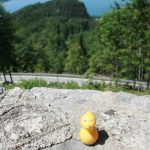
More important about Albrecht IV. however is the fact that he was the one who issued the “Münchener Reinheitsgebot” 30.11.1487, the oldest (?? Barbarossa Augsburg) food law of the world still effective, concerning the only legal ingredients of Bavarian Beer. An important ingredient is Hop (“Hopfen”). The law was extended to upper Bavaria later and to all of Bavaria 1516 by son Wilhelm IV. (1493-1550) which is quite handy as it gives the People of Munich a lot of opportunities to celebrate anniverseries. (500 years 25-26 July 2016, celebration in Munich, though canceled because of a amok attack). But even as early as 1156 the quality of beer was subject in the foundation of Augsburg 1156 by emperor Friedrich Barbarossa.
Duke Albrecht IV. is commemorted with a panel on the big “Maibaum” (maypole”) on the “Viktualienmarkt” in Munich.
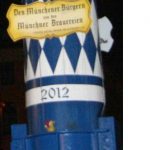
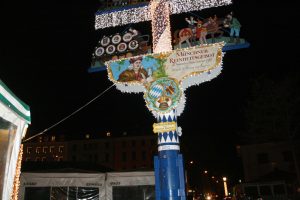


This Maypole which was renewed 2017 was again stolen in a striking coup 2017 (last time 1978) at the Viktualienmarkt Munich reminds of Albrecht IV. with a wooden Panel.
The church “St. Salvator” in Munich was built under the rule of Duke Albrecht IV. but wasn’t used after the “Säkularisierug” (secularisation 1802) by the Catholics. The lutheran community could not use it as too as it was still full of stuff and served as a depot. 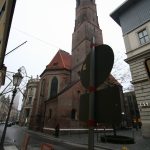 1828 King Ludwig I. (who supported the Greece independence 1830 and whose second son Otto become the first King of Greece by the will of the European leaders; of course they needed a big spender) gave the growing Greek Orthodox Community the right to use the church. There was a lawsuit about the rights of use between the Munich Community and the official Orthodox Community which ended in a decision of the German “Bundesverfasungsgericht“, the highest German court. The comunity is still very active in Munich celebrating Epiphanias on Munichs Isar Bridge every year.
1828 King Ludwig I. (who supported the Greece independence 1830 and whose second son Otto become the first King of Greece by the will of the European leaders; of course they needed a big spender) gave the growing Greek Orthodox Community the right to use the church. There was a lawsuit about the rights of use between the Munich Community and the official Orthodox Community which ended in a decision of the German “Bundesverfasungsgericht“, the highest German court. The comunity is still very active in Munich celebrating Epiphanias on Munichs Isar Bridge every year.
Schloß Dachau
Castle Dachau Dates back to mediaeval times and was enlarged under Wittelsbacher Duke Wilhelm IV. and son Duke Albrecht V. 1546-1577 and was the prefered summer Residenz of the Wittelsbacher during these days.
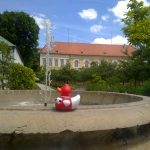


The garden of Castle Dachau is a pleasure to walk in and the coffee shop in the Castle offers great cakes and enjoyable Lounge Music.
The church “St. Michael” built between 1583 and 1597 was initiated by Duke Albrecht V. 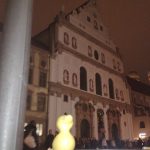 as a school of and for the Jesuiten. His son Duke Wilhelm V. the Pious then built the church with a massive, expensive unsupported barrel fault (second biggest of it’s kind). Bavarian Dukes and Kings are interred in the St. Michael chuch such as the most iconic one, “King Ludwig II.” who in the 19’th century also spent a lot of money. The church brought Wilhelm close to bancrupcy and in the end he could not afford to pay for all his employed musicians such as famous “Orlando Di Lasso”.
as a school of and for the Jesuiten. His son Duke Wilhelm V. the Pious then built the church with a massive, expensive unsupported barrel fault (second biggest of it’s kind). Bavarian Dukes and Kings are interred in the St. Michael chuch such as the most iconic one, “King Ludwig II.” who in the 19’th century also spent a lot of money. The church brought Wilhelm close to bancrupcy and in the end he could not afford to pay for all his employed musicians such as famous “Orlando Di Lasso”.
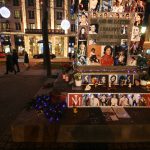 The Memorial for Orlando Di Lasso at the Promenadenplatz in Munich has a new purpose these days.
The Memorial for Orlando Di Lasso at the Promenadenplatz in Munich has a new purpose these days.
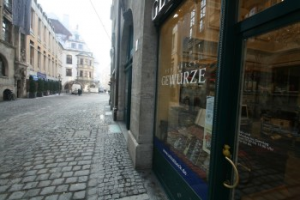 More rewarding was the founding of the “Hofbräuhaus” in Munich, first only for the royal household. It became a very profitable Business later under Kurfürst (elector) Maximilian I. (at the Platzl) That is, although the theft of beer mugs has always been a significant loss ever since. f.e. J.F.K.
More rewarding was the founding of the “Hofbräuhaus” in Munich, first only for the royal household. It became a very profitable Business later under Kurfürst (elector) Maximilian I. (at the Platzl) That is, although the theft of beer mugs has always been a significant loss ever since. f.e. J.F.K.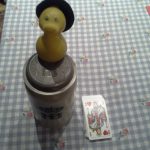
Altötting
Wilhelm V. is one of the Wittelsbacher who lost money to a Goldmaker. Marco Bragadino from Cyprus did the same to Duke Wilhelm V. as later Domenico Manuele Gaetano (count of Rudiero) Both were deperatly looking for money. Marco was executed in Munich 1591. His decaptivation did not go well as the executioner needed three strokes to kill poor Marco in front of a huge crowd which wanted to enjoy the very few entertainment events of that times.
Wilhelm in the end resigned in favor of his son “Kurfürst Maximilan I.” who started to save and to cosolidate the states finances. He was the first Duke of the Wittelsbacher whose heart is burried in “Altötting” 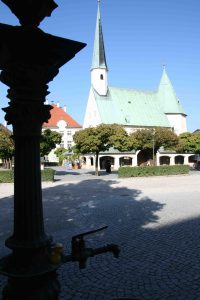 and so is the heart of his first wife Elisabeth Renata von Lothringen. But Altötting was important already before as burial site of Carolingian King Karlmann 830-880 or Karlomannus Rex Carloman I. (Grand Grandson of Charlemagne/Karl the Great.
and so is the heart of his first wife Elisabeth Renata von Lothringen. But Altötting was important already before as burial site of Carolingian King Karlmann 830-880 or Karlomannus Rex Carloman I. (Grand Grandson of Charlemagne/Karl the Great.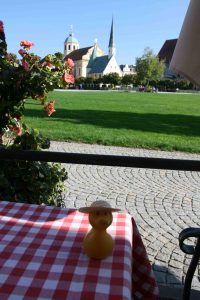
Elector Maximilian became the leader of the Catholic alliance in the “Thirty Years’ War” (1618-1648) and his commander-in-chief “Tilly” is commemorated with a statue in the “Feldherrnhalle” (left side) in Munich.
Duke and Elector “Maximilian I.” is commemorated with a giant equestrian statue on the “Wittelsbacherplatz” in Munich, close to Cafè Luitpold.
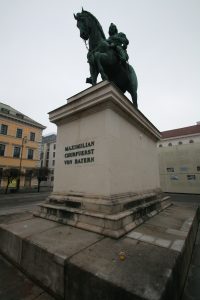 his General Tilly in the Feldherrnhalle
his General Tilly in the Feldherrnhalle 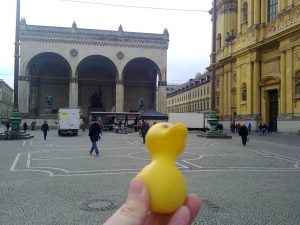
Important Player in the „Thirty Years‘ War“ on the Protestant side was Wittelsbacher „Winterkönig“ Friedrich V., son of „Friedrich IV.“ 1574-1610. Friedrich IV. is commemorated with a statue at the Heidelberger Schloss. (Palatina) 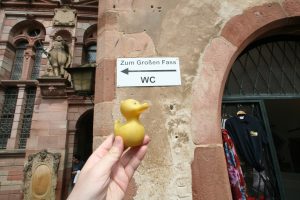 Friedrich IV. died early because of his exzessiv consumption of alcohol (here is a mocking song about him) and his young lutheran, unexperienced son 1592-1632, did not have much luck either as he got in between the european powers. Friedrich V. suffered from Malaria (mal air; not a tropical disease) which he caught from the mosquitos in the Heidelberger swamps. He became king of Bohemia , but only for a year (therefore mocked as „Winterkönig“ until he was beaten by Catholic cousin Maximilian, Maximilan’s commander in chief Tilly and the emperor 1620, toppled and had to flee from Prag and lost control of his Pfälzer reign.
Friedrich IV. died early because of his exzessiv consumption of alcohol (here is a mocking song about him) and his young lutheran, unexperienced son 1592-1632, did not have much luck either as he got in between the european powers. Friedrich V. suffered from Malaria (mal air; not a tropical disease) which he caught from the mosquitos in the Heidelberger swamps. He became king of Bohemia , but only for a year (therefore mocked as „Winterkönig“ until he was beaten by Catholic cousin Maximilian, Maximilan’s commander in chief Tilly and the emperor 1620, toppled and had to flee from Prag and lost control of his Pfälzer reign.
Neither Gustav Adolf from Sweden (Dynasty Wasa) who, though allied and successfull on the German battle field, was reluctant to give back the nice Pfalz. Nor England could or wanted to help in time. He was married with Elisabeth Stuart, daughter of king Jakob of England, Scottland and Ireland). Gustav Adolf and Ferdinand died 1632, Gustav on the battle field mysteriously shot in the back. Maximilian the winner on the popes side was rewarded with the inheritable title Elector 1623 which was confirmed 1628 by the Emperor Ferdinand II. and even Protestant electors. But the bavarian branch had to return that Pfälzer title to the Pfälzer side to Karl I. Ludwig, son of the Winterkönig after the „Westfälischer Frieden“ (peace contracts in Münster and Osnabrück) 1648 which finshed the 30 years war. But Maximilian stayed Kurfürst of Bavaria. Granddaughter of the Winterkönig was famous Liselotte von der Pfalz (Elisabeth Charlotte of the Palatinate) who is known for her excessive letter writing and is matriach of the dynastical line House Orléans.
During the time of Maximilian the consum of “White beer” (Weißbier) became very popular and a profitable source of income and due to an inheritage Maximilian came into possession of the “Weissbierregal”, the exclusive right to produce “Weißbier” and he founded numerous white beer breweries. 
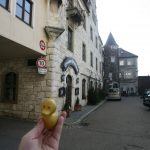 The first one in “Kehlheim” and Sheila was happy to be able to visit it and to enjoy the tasty beer and the Bavarian health food. The family “Schneider” in Munich 1872 was able to buy the right to brew “Weißbier” from King Ludwig II. 1872 and also bought the oldest Weißbier Brewery of Bavaria in Kehlheim 1924.
The first one in “Kehlheim” and Sheila was happy to be able to visit it and to enjoy the tasty beer and the Bavarian health food. The family “Schneider” in Munich 1872 was able to buy the right to brew “Weißbier” from King Ludwig II. 1872 and also bought the oldest Weißbier Brewery of Bavaria in Kehlheim 1924.
A lot of the income from beer was spent to pay for the war at Maximillians time.
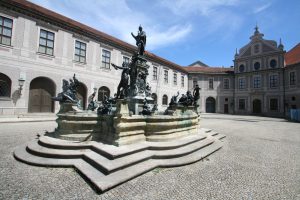 Kurfürst Elector “Kurfürst Maximian I.” also, after Wilhelm V. had already moved partly to this place, added new parts to the „Münchner Residenz“ such as the “Brunnenhof” (court of the founain) which he braught here from another place in Munich after he had inherrited it. It symbolizes 4 important Bavarian rivers, Isar, Donau, Lech, Iller.
Kurfürst Elector “Kurfürst Maximian I.” also, after Wilhelm V. had already moved partly to this place, added new parts to the „Münchner Residenz“ such as the “Brunnenhof” (court of the founain) which he braught here from another place in Munich after he had inherrited it. It symbolizes 4 important Bavarian rivers, Isar, Donau, Lech, Iller.
The fountain appears in this music – video.
Kurfürst Maximilian is intered in the Michaelskirche, his heart in Altötting. He left his son a financially healthy reign
Maximilan’s son Ferdinand Maria von Bayern („der Friedliebende“, who loved the peace) 1636-1679 follwed as elector from Bavaria.(grandson and godchild of Habsburger emperor Ferdinand II., mother: Maria Anna, daughter of Ferdinand)
Nymphenburg
Ferdinand Maria died in Schleißheim and is intered in the Theatiner church. He started the construction of Castle Nymphenburg and the Theatinerkirche (Stiftskirche St. Kajetan) in late baroque stile.
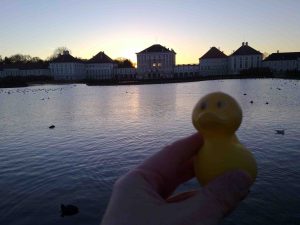

He also promoted art with the construction of the old opera next to the Salvatorkirche at the Salvatorplatz 1657. He kept out of territorial conflicts and kept distance both from France (Ludwig XIV.) and the Habsburger. He after long hesitation rejected the proposal of French Cardinal Mazerin (who followed Richelieu in France) to take over the office of German King and instead promoted the Habsburger Leopold I. He helped to fend off the Osmanic Expansion in the east. But he missed the chance to accomplisch the plan to buy the colony Nieuw Amsterdam (New York, USA) in the early 1660’ties. Instead he baught a lot of property at the more promising Starnberger See. (Castles Berg, Possenhofen, Kempfenhausen)
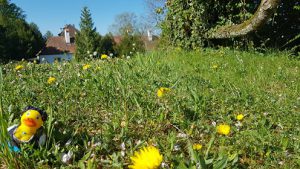
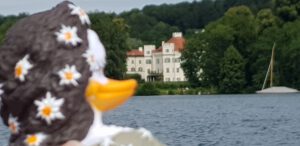
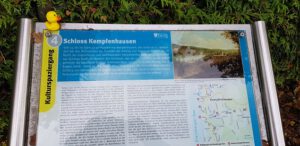

Visé Belgien
Contemporary Bishop of Cologne and Elector of Cologne , Bishop of Hildesheim and also Lüttich Liège Belgium was Prince Ferdinand von Bayern 1577-1650 and Maximilian Heinrich von Bayern 1621-1688. The Salt mine of Berchtesgaden was the possession of the bishopric Cologne. Visé in Belgium which contains the important Hadelinus -Shrine was part of their reign. A high councellor of Maximilian Heinrich intered his parent in the church of Visé next to the altar and ordered a grave monument with a memorial plate for them.


Schloß Schleißheim
Son of Ferdinand Maria, Maximilan II. Emanuel 1662-1726 “Kurfürst” (elector), other than Ferdinand, had the ambitions to become German emperor and married the daughter of the austrian emperor Leopold I. Maria Antonia from Austria. Therefore he built the big representative new Castle in Schleißheim in the town Oberschleißheim
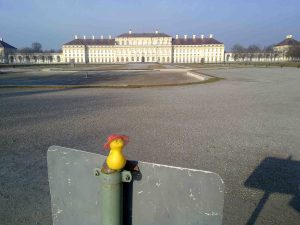
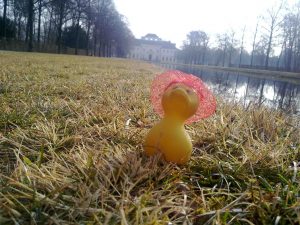
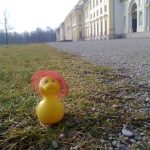
Sheila in front of Schleissheim and Lustheim castles
Oberschleißheim north of Munich but didn’t use it much after she and their male successors died early. He was an outstanding warrior fighting in the front lines who was wounded several times on the battlefield. He helped the Polish King Sobieski to free Vienna from the Turkish siege 1683. The Turkish gave him the nickname “Blauer König” (Blue King) due to the far visible blue uniform of the Wittelsbacher.
The new Castle Schleißheim (one of the most important baroque buildings in Germany) is connected to the smaller, older Castle Lustheim by a channel which is several hundred meter long. The New castle Schleißheim served as set for several movies such as “Three Musketeers” with Orlando Bloom 2011. The old Castle Schleißheim is also still there.
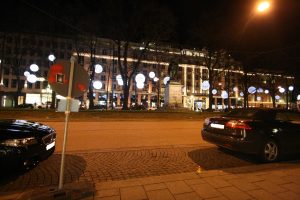 Max Emanuel is commemorated with a statue at the Promenadeplatz in Munich. He needed a lot of money but was exploited by a fraudster, the goldmaker and alchimist Domenico Manuele Caetano Earl of Ruggiero from the Napoli area in Italy. He barred Domenico Manuele in Castle Grünwald, but D.M. was able to escape to Austria. But he returned to Munich and got a second chance to make gold. But of course he failed again but could escape again after the invasion of Austria.
Max Emanuel is commemorated with a statue at the Promenadeplatz in Munich. He needed a lot of money but was exploited by a fraudster, the goldmaker and alchimist Domenico Manuele Caetano Earl of Ruggiero from the Napoli area in Italy. He barred Domenico Manuele in Castle Grünwald, but D.M. was able to escape to Austria. But he returned to Munich and got a second chance to make gold. But of course he failed again but could escape again after the invasion of Austria.
Here Luck Duck Sheila with the monument of Max Emanuel at the “Promenadeplatz”. Visible left behind the trees is famous “Hotel Bayerischer Hof“, ones the biggest hotel in Europe. The block also contains the Palais Montgelas, ones home of Minister of King Maximilian the I. The hotel is a leading hotel of the world and it hosts the annual Munich Security Conference, splendid balls and parties and many Stars stayed here. Such as Lola Montez 1846 (25) mistress of King Ludwig I.(60)
Michael Jackson stayed here and waved from the windows too and the monument of the renaissance composer Orlando – Di – Lasso was turned into the inofficial Michael Jackson memorial by his fans. (right in the background) Fans lay down flowers, candles , pictures since several years and there is a dispute going on about it, fans against the city and also fans against fans.
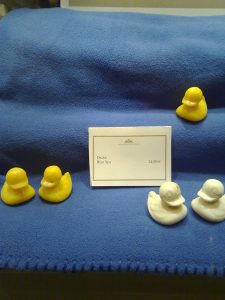
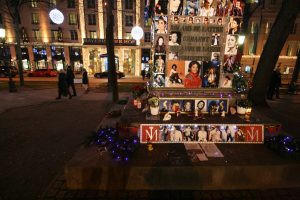
Here are some of Sheilas cousins who work in the promotion team of the splendid Blue Spa (a “Leading Spa”) in the the splendid “Bayerischer Hof” and alienated Memorial of Orlando Di Lasso.
1726 Max Emanuel’s son Karl Albrecht was following as bavarian ruler and became German Emperor 1742 Karl VII. Albrecht. He was the third german ruler/king and the second carrier of the title emperor of the Wittelsbacher after emperor Ludwig the Bavarian who became emperor 1328 and Ruprecht of the Pfalz 1400-1410 (German King). But Karl VII. Albrecht went through several wars and was already sick and had inherited a pile of debts from his father. After Austria invaded Bavaria he had to leave Munich for a while and died 1745 after his return to Munich in 1744 already sick after wars and exil.
He is interred in the “Theatinerkirche” in Munich.

The “Theatiner” – Church is partly visible on the right side. (yellow building) The Feldherrnhalle and the Theatiner-Church appear in this music video.
The Odeonsplatz is also used for open air Events such as the concert “Klassik am Odeonsplatz”. Edmund Stoiber who joined again 2017 (Uschi Glas was there too) provided a nice new statement about music. (the original link is gone but it ist on youtube; about 6 min. after the start; Sheila neither thinks, Helene Fischer is old nor that the Beatles are new):“Ich höre alles gerne wenn an einem -äh- schönen Sommernachmittag wenn ich zuhause bin dann dann höre ich natürlich gerne Popmusik -äh-,die Neuesten(‘1′), die Alten (alten?’2’),von den Beatles (‘1’) bis zu Hilli (Helene) Fischer (‘2’)
und -äh- fühle ich mich einfach dann bischen urlaubsmäßig.”
Tambosi
Near by on the other side of the Odeonsplatz is the legendary Luigi Tambosi coffee and restaurant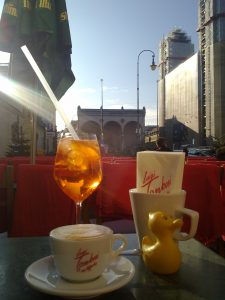 where you can sit outside in the warm sun and enjoy the wonderful athmosphere of the place, the street musicians, happy dancing Hare-Krishna followers and the treats of the coffee. The Tambosi is directly at the wall of the Hofgarten which entitles it to be mentioned on this Wittelsbacher site. The Tambosi also uses the arcades inside of the Hofgarten and Sheila recommends to visit it’s dinner and opera events. Thats opera, fun and good food at the same time. Tambosi is Munichs oldest operating coffee shop. The family had their roots at the “Lake Garda”, Tyrol. Giuseppe Tambosi served King Maximilian II. and seems to have had a very close relation to the family of the king. Giuseppe Tambosi lived next door to the Countess of Landsfeld in the Barerstr. for a while, also known as Lola Montes, mistress of King Ludwig I.
where you can sit outside in the warm sun and enjoy the wonderful athmosphere of the place, the street musicians, happy dancing Hare-Krishna followers and the treats of the coffee. The Tambosi is directly at the wall of the Hofgarten which entitles it to be mentioned on this Wittelsbacher site. The Tambosi also uses the arcades inside of the Hofgarten and Sheila recommends to visit it’s dinner and opera events. Thats opera, fun and good food at the same time. Tambosi is Munichs oldest operating coffee shop. The family had their roots at the “Lake Garda”, Tyrol. Giuseppe Tambosi served King Maximilian II. and seems to have had a very close relation to the family of the king. Giuseppe Tambosi lived next door to the Countess of Landsfeld in the Barerstr. for a while, also known as Lola Montes, mistress of King Ludwig I.
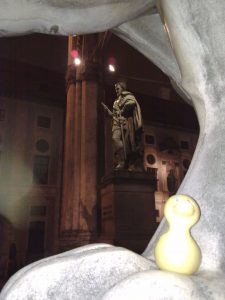 The other building in the middle is the 1841 – 1844 built “Feldherrnhalle” (under the order of Ludwig I. ) Commander – in – chief Tilly of Elector Maximilan I. (catholic alliance in the 30 years war 1628-1648) is commemorated here. There is also a armee memorial set up by Prinzregent Luitpold in the Feldherrnhalle.
The other building in the middle is the 1841 – 1844 built “Feldherrnhalle” (under the order of Ludwig I. ) Commander – in – chief Tilly of Elector Maximilan I. (catholic alliance in the 30 years war 1628-1648) is commemorated here. There is also a armee memorial set up by Prinzregent Luitpold in the Feldherrnhalle.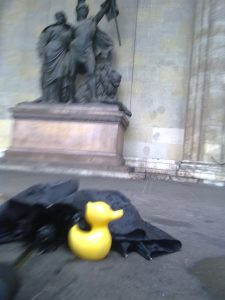
Later after Adolf Hitlers failed attempted revolution (“Marsch auf die Feldherrnhalle 1923” which started at the Bürgerbräukeller) it was a special place for Nazi Propaganda in the “Capital of the Movement” (Munich).
With the death of the son of Karl VII. Duke Maximilian III. the bavarian branch of the Wittelsbacher ended and a war about the heritage started. The “Pfälzer” (region in Germany) -branch of the Wittelsbacher took over the heritage. The war against Austria did not cause much battles, most challenging was feeding the soldiers, the war 1778-79 was therefore called “Potato War”. There was also a „Potato Revolution“ or the the American Pig War, where potatos playes an important role.
Klemens August Bishop of Cologne, another son of Maximilian II. Emanuel and 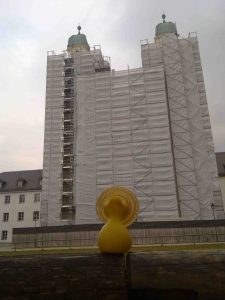 powerful ruler and “Kurfürst” (elector) founded the church St. Michael (under construciton March 2014 ) outside of the old town of Munich in “Berg am Laim” (today a suburb of Munich) competing with his brother, the (emperor Karl VII.) in their ambitions to promote art.
powerful ruler and “Kurfürst” (elector) founded the church St. Michael (under construciton March 2014 ) outside of the old town of Munich in “Berg am Laim” (today a suburb of Munich) competing with his brother, the (emperor Karl VII.) in their ambitions to promote art.
Clemens August, ruler of several bishoprics , among them Cologne built several Castles at Brühl, close to Cologne: Castle Brühl. Though being a bishop he had numerous affairs and mistresses and his daughter Anna Maria nominated noble Anna Maria zu Löwenfeld was bewedded to the illegitimate son of his brother Karl VII Albrecht (emperor). Sheila says it is OK as long as it stays in the family.
Köln
Brühl
Sheila visited the Castle Brühl, but taking pictures is not allowed. But I could take one picture in the Ducks Room.
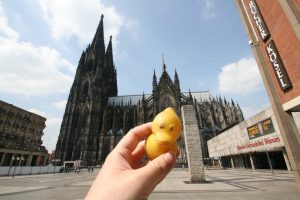
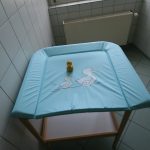
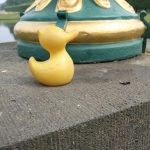
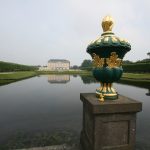
——-
Koblenz
Clemens August died 1761 during the seven years war in the Kurfürstentum Trier outside of his own reign in Castle Philippsburg which was part of fortress „Ehrenbreitenstein“ situated high above the fork of the Rhine and Mosel river. Philippsburg and Ehrenbreitenstein were blown up by Frensh troups 1801.

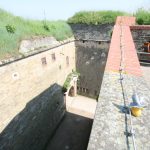
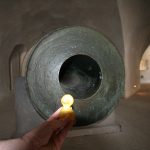
Mannheim
New ruler of Bavaria became the Pfälzer Wittelsbacher Karl Theodor (Pfalz and Bavaria). He favoured his western territory ruled some time from Mannheim 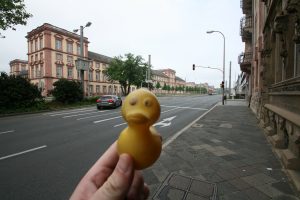 and was considering to exchange Bavaria for Dutch territories closer to his “Pfälzer” home. Sheila visited Castle Mannheim which puts up a University today.
and was considering to exchange Bavaria for Dutch territories closer to his “Pfälzer” home. Sheila visited Castle Mannheim which puts up a University today.
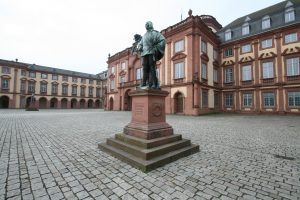 Kurfürst Karl Ludwig von der Pfalz , son of Winterkönig Friedich V. von der Pfalz in front of the big Mannheimer Castle, now a University and Theater. Friedrich Schiller worked here at the Theater, partly illegally at that time.
Kurfürst Karl Ludwig von der Pfalz , son of Winterkönig Friedich V. von der Pfalz in front of the big Mannheimer Castle, now a University and Theater. Friedrich Schiller worked here at the Theater, partly illegally at that time.
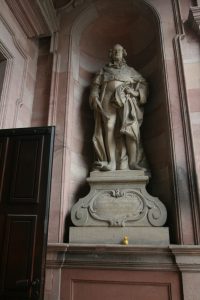 Kurfürst Karl Theodor, born in Castle Drogenbusch close to Brussels 1724 † 1799 in the Residenz in Munich, intered in the Theatinerkirche in Munich, at the „Jesuitenkirche“ in Mannheim,
Kurfürst Karl Theodor, born in Castle Drogenbusch close to Brussels 1724 † 1799 in the Residenz in Munich, intered in the Theatinerkirche in Munich, at the „Jesuitenkirche“ in Mannheim, 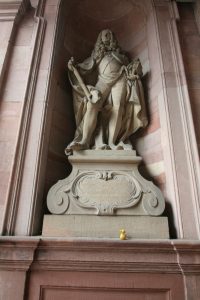
and to the right his father Kurfürst Carl Philipp who built the church and braught the Jesuits to follow him from Heidelberg to Mannheim. (Grand Grand father of Maximilian I. King of Bavaria)
Karl Theodor provided for the „Golden Age of Mannheim“ where he promoted art, music, opera and theater. He also staged several of Voltaire’s pieces. Voltaire had left Berlin before but Karl Theodor spent too much money on Voltaire. Karl even asked Voltaire to pay back some of the money spent. Mozart was here 1777, gave concerts and was employed as music teacher for the Kids of the elector. Karl started the Mannheimer Nationaltheater with star Friedrich Schiller („Die Räuber“) even after he had left to Munich.
He was not popular in Bavaria as he was considering to trade Bavaria for the Netherlands. But that failed due to the resistance of Friedrich II. of Prussia. But after loosing territories to Napoleon in the West he made himselve home in Munich. He (by deploying colorfull Count of Rumford = Sir Benjamin Thomson, a british – american scientist, famous for underwear and soup) created the “Englischer Garten”, the biggest public garden world wide. During his time the “Chinesischer Turm” was built and it is a major attration in Munich ever since. Sheila likes to have a spoonfull of beer here once in a while. And she likes the park as well.
The Rumford-soup was criticized by Karl Marks:
“American nonsense, counterfeited goods”. People said about it’s recipe: You can put anything in the soup,
“was rum liegt und was fort muss” (what lies around and needs to be put away as it started to rot). Heinrich Heine mentioned it too, dragging out all joy of life of the people.
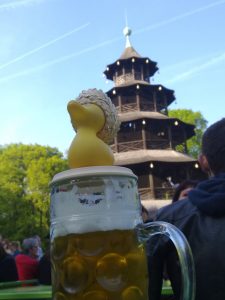
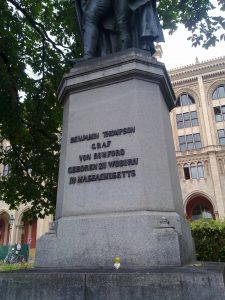
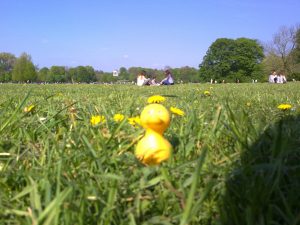
Karlspatz Stachus
Chinesischer Turm
 The “Karlsplatz” (named also Stachus due to a popular inn run here bei Eustachis Föderl” is named after Karl-Theodor. It appears in this music video.
The “Karlsplatz” (named also Stachus due to a popular inn run here bei Eustachis Föderl” is named after Karl-Theodor. It appears in this music video.
Karl Theodor also improved the salt production in Reichenhall after the Wittelsbacher since the end of the 15’th century baught more and more of the salt producing rights from commoners who no longer could afford the rising Investments for the production. He is commemorated in the Salt mine in Berchtesgaden with a relief.
Though having many children (I counted 8 from his first wife and different mistresses), Karl Theodor had neither surviving children with his first wife nor with his second young wife Maria Leopoldine von Österreich-Este, who was forced to marry him but rejected to have sex with him. She was 18 when she had to marry him, he already 70. Maria Leopoldine became important for Bavaria as she organised the heritage in favour of the Wittelsbacher Line Pfalz -Zeibrücken short before and after Karl Theodors death. She was a unusual self confident and emanzipated women for her time and a clever business women later. She prevented a visit of a austrian envoy who tried again to get Karl Theodor to sign a contract to trade Bavaria for Dutch territories while he was already in his deathbed. Therefore the closest related male family member, grandson of the sister of Karl Theodor inherrited the titles and territories. And Bavaria by that stayed in the hands of the Wittelsbacher. King Ludwig I. of Bavaria later thanked her 1845 for that. Maria Leopoldine received a good income as widow of Karl but also made a lot of Money from buying, improving and selling many breweries. She had the Reputation to be the richest women in Bavaria. 1804 she married Ludwig Count of Arco (seat of the Dynastie: Arco at the Lake Garda, Tirol).
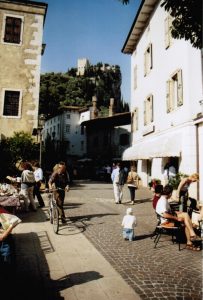
The origin of that Family is unclear but one option is that they steem of the Counts from Bogen -Dachau-Shyren, the same area the Wittelsbacher came from at a time, then the Wittelsbacher were not yet called Wittelsbacher (Bogen=Arch=Arcor). Maria Leopoldine gave both of their sons big representive Palais in Munich Close to the Residenz as presents for their marriadges.
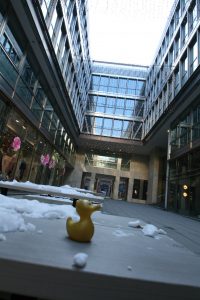 She also made a lot of money with stock deals and liked to travel.1848 she died after an accident with her carriage at the Achatzberg in Wasserburg. 1822 the Counts of Arco auf Valley inherited Castle and brewery Maxlrain and 1870 a son of Maria, Max Count of Arco-Zinnenberg baught Castle Maxlrain for his son Ludwig. Maxlrain was awarded the title brewery of the year 2012.
She also made a lot of money with stock deals and liked to travel.1848 she died after an accident with her carriage at the Achatzberg in Wasserburg. 1822 the Counts of Arco auf Valley inherited Castle and brewery Maxlrain and 1870 a son of Maria, Max Count of Arco-Zinnenberg baught Castle Maxlrain for his son Ludwig. Maxlrain was awarded the title brewery of the year 2012.
Maxlrain
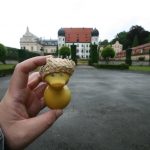

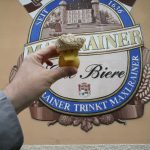
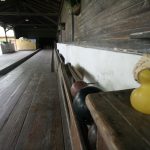
The Castle Inn where you can enjoy the excellent beer also has a rare old typical old fashioned bowling alley. A „Count of Arco“ also appears as messenger of King Maximilian II. in the famous Sissi movy (first of the trilogy) telling „Zither-Maxl“ to further show adequate behaviour after the engagement of daughter Sissi with the austrian emperor.
King Maximilian I. Joseph (popularaly called King Max), former Duke Maximilian IV. was the first bavarian king. He was born 1756 in Schwetzingen close to Mannheim and grew up in France , like in Straßbourg at his uncle Duke of Zweibrücken as his father died early and his mother Maria Franziska of Pfalz-Sulzbach was leading a inadequate life. She had a relation with a actor from Mannheim.
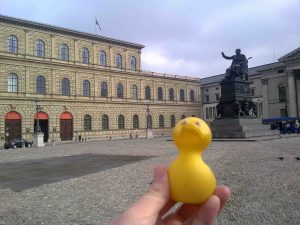
Maximilian I. Joseph’s († 1825 1625) alliance with Napoleon I. brought the Wittelsbacher 1806 the title: King of Bavaria and many bavarian men the death on Napoleons battle fields and empty barns and pantries. Bavaria also ows the possession of Franconia with it’s wineries and Nürnberg (Nuremberg) to Napoleon. The Franconians never felt at home in Bavaria (some still consider themselves as Rucksack-Bayern what they don’t like as stated in the Frankenlied with verse 7. But this might change now as Markus Söder (some call him the „Mausdoadschmatzer“ my Translation: bullshitter) from Franconia is likely to become the next bavarian president and continue the good catholic traditions of bavarian rulers.

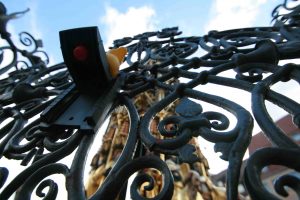
Sheila at the Main at Nordheim (famous wine: Nordheimer Vögelein) and at the „Schöner Brunnen“ with the famous Luck Ring which she had to turn in Nürnberg in Franken.
Fortunately Max changed sides just in time and left Napoleons side and could keep the title and terretories after Napoleon was overcome. He and his Minister Count Montgelas expropriated the churches and monasteries. (“Säkularisierung”). And he was not really a enemy of Napoleon, he put some dynastical hopes on Napoleon. after he forced his daughter Auguste Amalie Ludovika to marry a stepson of Napoleon Eugène de Beauharnais.
The daughter at that time was already engaged to another man but had to subject. Napoleon had no own sons at that time but needed some nobality in his family to justify his dynastical claims of ruling. It was a deal with Maximilian I., no daughter, no kingdom. After Napoleons defeat Eugène and his wife moved to Munich and Eugène received the title “Duke of Leuchtenberg” from his father in law Maximilian. They then lived in the Palais Leuchtenberg in Munich. (today the Bavarian Department of Finance)
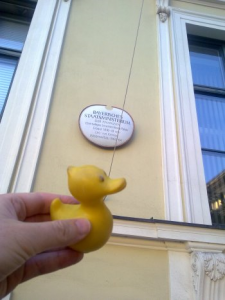
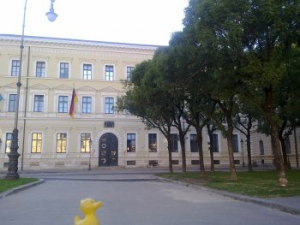
(also visible further down behind a statue of King Ludwig I. ) Ludwig I. and his father Maximilian had an argument about the palais, but reconsilliated. Daughter of Eugène and Auguste was Josephine who after cleverly continuing politics by marriage married crown prince and later King Oskar I. of Sweden and Norway (Bernadotte). Architect Leo von Klenze realized the first odourless toilet (frensh: fosses inodores et mobiles) in this city palais. Auguste Amalie (Vize Queen of Italy for some years under the reign of Napoleon) and Eugène also had a residenze in Castle Ismaninig north of Munich
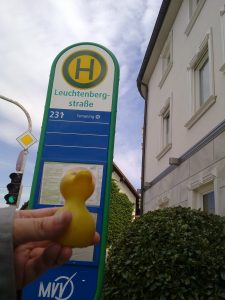
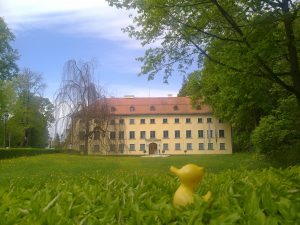
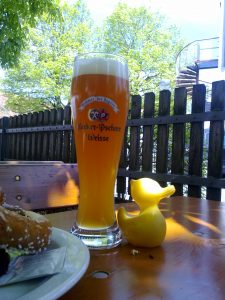
which they liked a lot in summer. Their title given to Eugène by his farther in law Max is commemorated with this street name next to the Castle. Pictures of Eugene and his wife can be seen in a museum Close to the Castle.
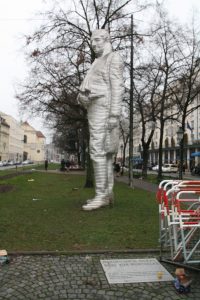 Contemprary Statue of Count Montgelas on the “Promendenplatz” in Munich in front of the “Palais Montgelas“, today part of Hotel “Bayerischer Hof”.
Contemprary Statue of Count Montgelas on the “Promendenplatz” in Munich in front of the “Palais Montgelas“, today part of Hotel “Bayerischer Hof”.
King Max is interred in the Theatinerkirche. King Max liked to walk in parks and founded the Old Botanical Garden in Munich (“Alter Botanische Garten“) whose entrance carries a inscription of “Johann Wolfgang Von Goethe (see Broken Hartz)” to honor King Max.
Alter Botanischer Garten
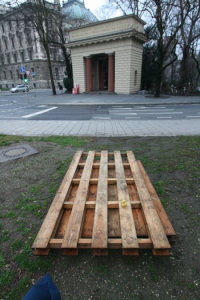
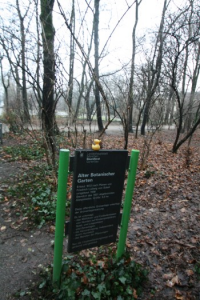
FLORVM DAEDALAE TELLVRIS GENTES DISSITAE MAXIMILIANI IOS. R. NOMINE CONSOCIATE, MDCCCXII
All terrestrial flowers are brought together here by the order of King Maximilian Joseph 1812
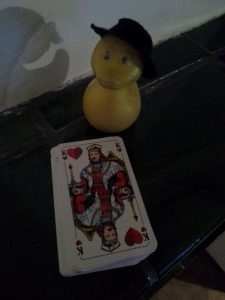 The highest card in a popular bavarian card game “Watten” is named after that king, the “Maxl”, king of hearts. Some say, “Watten” is per definition an illegal game of hazard in Germany but it is part of Bavarian culture. It is normally played by 4 players in two teams and cheating by giving signals to your partner is a art and common and legal (“Deitn”)
The highest card in a popular bavarian card game “Watten” is named after that king, the “Maxl”, king of hearts. Some say, “Watten” is per definition an illegal game of hazard in Germany but it is part of Bavarian culture. It is normally played by 4 players in two teams and cheating by giving signals to your partner is a art and common and legal (“Deitn”)
Max – Joseph memorial at Max-Joseph Platz in front of the Opera and the Residenz. 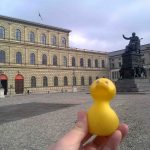 Sheila
Sheila
The Opera house which is among the most important opera house world wide offers almost daily performances is a most streemlined equipped opera house today though being in an old outstandig building which had to be rebuilt thouch twice after burning down, last tim in WWII. 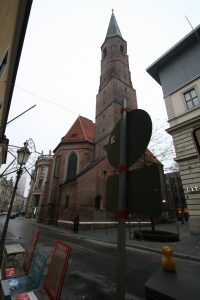 It is not the first opera house in Munich though, the first one which was at the Salvatorplatz dates back to 1657 which maybe with the Opera in Vienna is the oldest Opera in Europe.
It is not the first opera house in Munich though, the first one which was at the Salvatorplatz dates back to 1657 which maybe with the Opera in Vienna is the oldest Opera in Europe.
on the back of the Residenz in the “Hofgarten” (court garden)
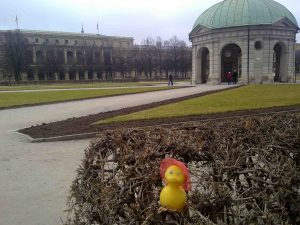
The shown rondell in the Hofgarten is sometimes used these days in summer for Tango Dancing.
Max I. 1811 founded a insurance company, the “Bayerische Landesbrandversicherungsanstalt”, now part of the group “Versicherungskammer Bayern”. At the moment the company is running a campaign to point out the fact of it’s historical importance and the good intentions of the founder. Today at a local fare Sheila found this sales stand with a game where you could win a price if you count the right number of ducks in the container (Ducks are a important aspect in the insurance business). I doubt that squeesing the Ducks together in such a small tube complies with the TARF regulations.
of the group “Versicherungskammer Bayern”. At the moment the company is running a campaign to point out the fact of it’s historical importance and the good intentions of the founder. Today at a local fare Sheila found this sales stand with a game where you could win a price if you count the right number of ducks in the container (Ducks are a important aspect in the insurance business). I doubt that squeesing the Ducks together in such a small tube complies with the TARF regulations.
After the Secularisation 1803 Max was also able to buy property of the dissolved monastery Tegernsee and coined this area after that. Parts here are still owned and operated by the Wittelsbacher. Like the Dukes „Herzogliches Bräustüberl Tegernsee“.
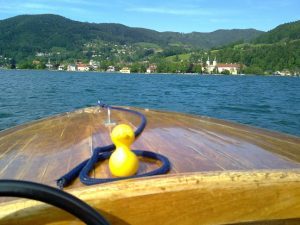
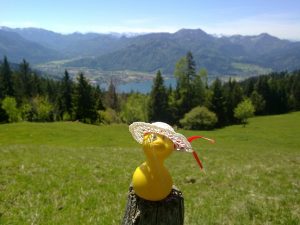
or the Königsalm
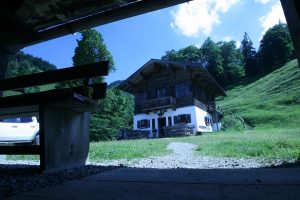
Maximilian I.’s son King Ludwig I. (Born 1786 in Straßburg, † 1868 in Nizza) married Therese von Sachsen-Hildburghausen 1810 and the wedding celebration staged by King Max with a horse race became the origin of the Oktoberfest in Munich on the “Theresienwiese” (d’Wiesn“, not d’Wies !).
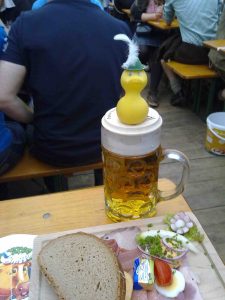
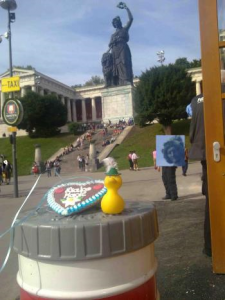
Statue of the Bavaria in front of the “Ruhmeshalle”, erected under Ludwig I. (it appears in this Video)
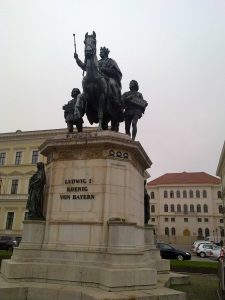 Statue of Ludwig I. at the Odeonsplatz, Palais Leuchtenberg in the Background. (!! with a crown, he never wore a crown !!)
Statue of Ludwig I. at the Odeonsplatz, Palais Leuchtenberg in the Background. (!! with a crown, he never wore a crown !!)
Ludwig I. installed the “Schöhnheitsgalerie” (Galarie of Beauties) in Nymphenburg Castle which also contains a painting of Lola Montez (Elizabeth Rosanna Gilbert) a dancer and mistress of King Ludwig I.  He gave her the title of Countess of Landsfeld and generours presents. In the revolution 1848 which caused the King to resign, she fled to Swizerland. Lola Montez later moved to the USA and appeared on the Broadway where she played herself (1852 Broadway “Lola Montez in Bavaria”).
He gave her the title of Countess of Landsfeld and generours presents. In the revolution 1848 which caused the King to resign, she fled to Swizerland. Lola Montez later moved to the USA and appeared on the Broadway where she played herself (1852 Broadway “Lola Montez in Bavaria”).
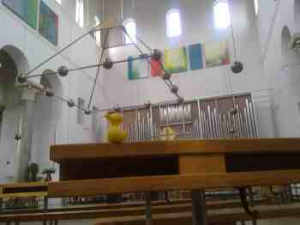 Ludwig I. and his wife are interred (Ludwig in a gigantic sarcophagus) in the “Basilika St. Bonifaz” in Munich which belongs to a monastery called “St. Bonifaz” which he had founded. He already placed the sarcophagus there while he was still alive. His wife Therese, a Protestant after being moved serveral times is now burried visible in the wall behind her husband in the catholic church. Sheila thinks it’s great to be a ruler.
Ludwig I. and his wife are interred (Ludwig in a gigantic sarcophagus) in the “Basilika St. Bonifaz” in Munich which belongs to a monastery called “St. Bonifaz” which he had founded. He already placed the sarcophagus there while he was still alive. His wife Therese, a Protestant after being moved serveral times is now burried visible in the wall behind her husband in the catholic church. Sheila thinks it’s great to be a ruler.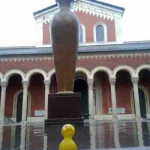
Königsplatz
The monastary is one block behind the picturesque “Königsplatz” in classical stile also installed by King Ludwig I. There are many museums in that district. The place played a important role during Nazi – rule. Today sometimes open air concerts are staged on this place. Anna Netrebko and Jonas Kaufmann (born in Munich and star at the Bayerische Staatsoper in Munich) 10 had an outstanding perfomance here 2015.
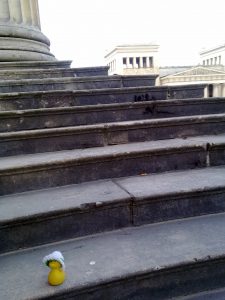
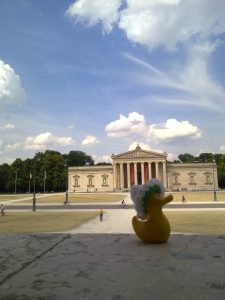
The NAZIS installed marble panals on the place to create a nice sound when their troups were maching over it and played a important role under NAZI rule. But they forgot, that if there was rain the whole place was covered with water which could not seep away. Therefore the place received the foul name Plattensee (which refers to the „Plattensee“ (german) in Hungari „Lake Balaton“)
Sheila on the stairs of the State Antiquities Collection “Staatliche Antiquitätensammlung” , visible too the “Glyptothek” (appears in this Video) and a little bit of the “Propyläen”.
Part of monastery Bonifazius is as a sub monastery “Kloster Andechs” which is well know in the area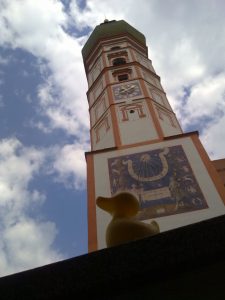 for it’s brewery on the popularely called “Holy Mountain”. That monastery was expropienated by Ludwig’s I. father during the “Säkularisation” but Ludwig I. (problably to compensate for his sins) bought it back and gave it to the new monastery which he founded.
for it’s brewery on the popularely called “Holy Mountain”. That monastery was expropienated by Ludwig’s I. father during the “Säkularisation” but Ludwig I. (problably to compensate for his sins) bought it back and gave it to the new monastery which he founded.
Here is one picture of Andechs but I will post a Andechs special soon.
Nymphenburg Castle hosts a Painting Galeri with pictures of pretty women, the “Schönheitsgalerie”. One portrait is a painting of Lola Montez.
Sheila enjoyed a wonderful sunset with the sun going down behind the windows on both sides of the entrance hall of the castle Nymphenburg.

Nymphenburg Castle appears in this music video.
A student 1848 insulted Lola Montez in a lampoon which he pinned on the “Residenz” in Munich and King 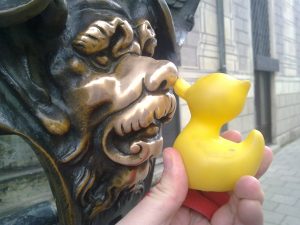 Ludwig I. promised a reward if the culprid would be found. While the student tried to attach a confession on the Residenz he was caught and braught to the king. After talking to him the king amnestied the student and even gave him the bounty money. After leaving the “Residenz” the students knees where getting weak and he had been seen holding on to one of the lion heads in front of the “Residenz” with a bag full of money. Since that time it’s considered good luck to rub the lions nose.
Ludwig I. promised a reward if the culprid would be found. While the student tried to attach a confession on the Residenz he was caught and braught to the king. After talking to him the king amnestied the student and even gave him the bounty money. After leaving the “Residenz” the students knees where getting weak and he had been seen holding on to one of the lion heads in front of the “Residenz” with a bag full of money. Since that time it’s considered good luck to rub the lions nose.
Something Sheila couldn’t miss, just like turning the luck ring in Nuremberg. You can see the brightness of the many rubs. Actually there are 4 (not just two as mentioned here before) lions 2 at 2 different exits and it is not known which one was the one. So better rub all noses.
Luck Duck Sheila with the Luck Lion at the Residenz and sitting on the memorial of Ludwig I at the “Odeonsplatz”. Remarkable is, that the King is here wearing a crown on his head, not the coronation crown though. The royal Wittelsbacher crown itselve was not worn, not even during coronation. The famous jewel “Blauer Wittelsbacher” which once was part of the coronation crown was sold several times in the past 10o years.
Geschwister Scholl Platz
Siegestor
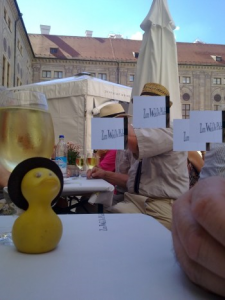 Sheila visited the Pfälzer Hof to enjoy some of the Pfälzer wine at the Pfälzer wine Party in the Residenz and than walked through Schwabing to the Siegestor. Drinking wine and wine parties are popular in Munich, probably cause of the Relations with Frankonia an the Pfalz.
Sheila visited the Pfälzer Hof to enjoy some of the Pfälzer wine at the Pfälzer wine Party in the Residenz and than walked through Schwabing to the Siegestor. Drinking wine and wine parties are popular in Munich, probably cause of the Relations with Frankonia an the Pfalz.
Pfälzer Hof in the Residenz annual wine festival Siegestor, Geschwister Scholl Platz in front of the Ludwigs-Maximilians-University (LMU München) . Austrian artist Wolfgang Flatz studied here art history.
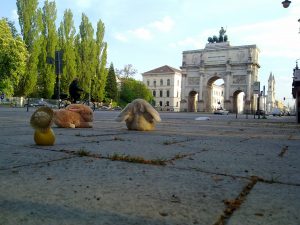
Siegestor at the end of the “Ludwigstraße”, ordered by King Ludwig I. built 1843 to 1850
Ludwig I. also built the “Monopteros” in the “Englischer Garten“.
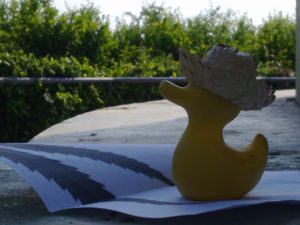
And the “Bavarian Hall of Fame” above the Theresienwiese in Munich with the colossal statue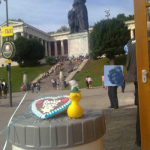 “Bavaria”,
“Bavaria”,
The Bavaria appears in this music video.
the “Wallhalla” on the Banks of the Danube river and the “Befreiungshalle” by “Kehlheim”.

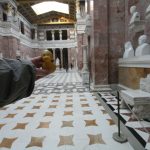
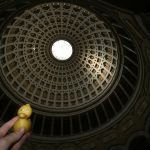
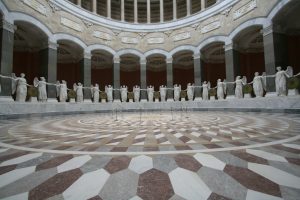
The big Kriegsgöttinnen goddesses of war also appear in the Casino on the Roseninsel in the Starnberger See s.further down much smaler though and taking Pictures there was not possible.
Ludwigskirche
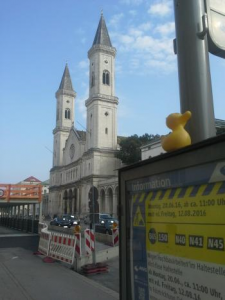 Under Ludwig I. the Ludwigskirche was built between 1829 and 1844 is the first monumental church in round bow stile which possesses the second biggest altar fresco world wide. The first draft was created by Leo von Klenze (classizistic architect, painter, writer) who became private and court architect of Ludwig I. 1815 coining the looks of Munich. He also drafted the New Erimitage in St. Petersburg Russia and classizistical redecoration of Athens (not much of which remained), during Greece under the reign of King Otto I. of Greece. Klenze also built the first toilet without smell in the Palais Leuchtenberg. The new church was necessary as Leo von Klenze’s projects caused another church being put down.
Under Ludwig I. the Ludwigskirche was built between 1829 and 1844 is the first monumental church in round bow stile which possesses the second biggest altar fresco world wide. The first draft was created by Leo von Klenze (classizistic architect, painter, writer) who became private and court architect of Ludwig I. 1815 coining the looks of Munich. He also drafted the New Erimitage in St. Petersburg Russia and classizistical redecoration of Athens (not much of which remained), during Greece under the reign of King Otto I. of Greece. Klenze also built the first toilet without smell in the Palais Leuchtenberg. The new church was necessary as Leo von Klenze’s projects caused another church being put down.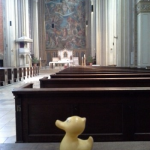
The Ludwigskirche then was created by other famous achitect and competitor of Klenze, Friedrich von Gärtner.
There is a memorial plate next to the Ludwigskirche of Leo von Klenze although he did not built the Ludwigskirche. The church is the University Church for the neighbouring Ludwig-Maximilians Univerity.
Ludwig I. did not like the fresko created by Peter von Cornelius and let Cornelius down after that, who than moved to Berlin.
A famous younger brother of Ludwig was Prinz Karl von Bayern (he died 1875 at the Tegernsee thrown down by his horse) who lost his and his childrens claims on the Bavarian throne as he loved and married Marie-Anne-Sophie Petin which was a inapproiate connection. Considering that he and his wife lived in the “Prinz Karl Palais” next to the “Eisbach” brook in the park “Englischer Garten” and not far from the Isar river this was a dangerous situation for Marie. (see Agnes Bernauer further up).
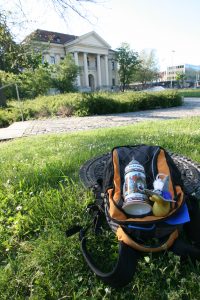 Prinz Karl made a military career and help brother Ludwig during the revolution 1848 and calmed down the puplic unrest. Ludwig I. had to resign nevertheless. He possessed the military barracks in Ausburg, “Prinz Karl Kaserne” 3. Infantrie Regiment and soldiers who served at that time used to buy souvenir mugs of their military time. The Prinz Karl Palais today is the seat of the bavarian president where frequently formal wellcomes take place. (at the side of the “Hofgarten” and the bayersiche Staatskanzlei).
Prinz Karl made a military career and help brother Ludwig during the revolution 1848 and calmed down the puplic unrest. Ludwig I. had to resign nevertheless. He possessed the military barracks in Ausburg, “Prinz Karl Kaserne” 3. Infantrie Regiment and soldiers who served at that time used to buy souvenir mugs of their military time. The Prinz Karl Palais today is the seat of the bavarian president where frequently formal wellcomes take place. (at the side of the “Hofgarten” and the bayersiche Staatskanzlei).
Prinz Karl (Carl Theodor) was also offered the greek throne 1831 but rejected and Prinz Otto his nephew , son of Ludwig I. became greek king from 1832-1862 until to the revolution in greece.Prinz Karl (Carl Theodor) and his wives are burried in a Mausoleum above Söcking at the Starnberger See (former Würmsee). The spot was hard to find and the forest is claiming back it’s rule on the hill which limits the view.
Carl Neudel composed and dedicated Prinz Karl a Military march, the Prinz Carl Marsch.
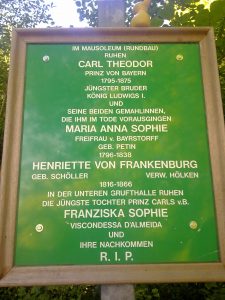
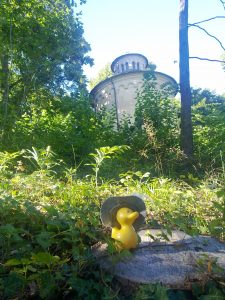
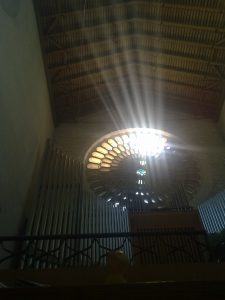 Church St. Ulrich in Söcking with a outstanding window is near by.
Church St. Ulrich in Söcking with a outstanding window is near by.
Hohenschwangau
It was King Maximilian II. (born 1811, + 1864) who completed Castle “Hohenschwangau” about 130 km west of Munich as his summer residence. It was here where later King Ludwig II. and his brother King Otto I. spent much of their childhood.
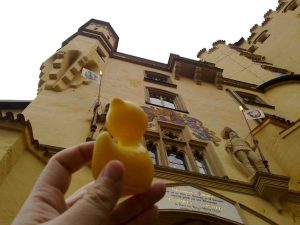
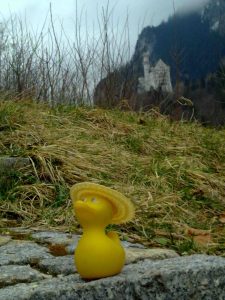
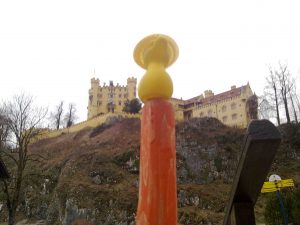
Sheila enjoyed the view from above on the way to the “Marienbrücke” and from below from the enterprising village “Hohenschwangau”.
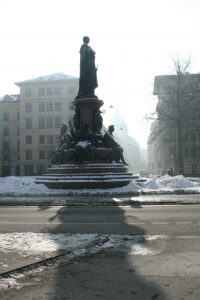 King Maximilian II. who created the looks of the “Maximilianstr.” in Munich is commemorated in Munich in that street with a statue, the “Max Zwoa Denkmal” (Max II. Monument)
King Maximilian II. who created the looks of the “Maximilianstr.” in Munich is commemorated in Munich in that street with a statue, the “Max Zwoa Denkmal” (Max II. Monument)
Roseninsel
He also baught the “Roseninsel” close to Possenhofen and built a timid Villa on it as summer residenze. Due to lack of money he couldn’t built a big Castle at the Würmsee (Starnberger See) of which plans exist. He liked travelling. He died early at the age of only 52 by a unclear sickness, even before his father Ludwig who retreated 1848 .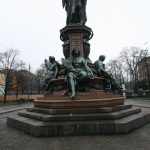

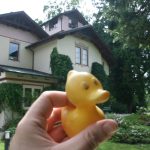
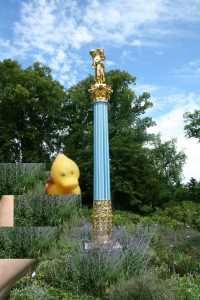

Maximilian II. was married with Marie Friederike von Preußen, the column upon is a prussen present. Marie loved to travel in Bavaria and was popular among the People. She also loved to hike in the mountains and climed on the Watzman 2713 m at Berchtesgaden 1854. Her husband did not allow her though to climb on the Zugspitze (almost 3000 m) as first women but she did that after Max II. had died.
Zugspitze 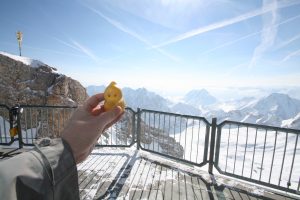
One son of Ludwig I. was Otto. Otto I. of Greece, the pitiable boy (“Der arme Junge” uncle emperor Franz Joseph from Austria) was nominated to become Greek king when he was only 16 and arrived in Greece with several thousand civil servants and soldiers from Bavaria when he was 17. The Greek orthodox officials rejected to anoint the catholic king in a religious ceremony and he did not wear anything on his head when he was sworn in 1844 on the Greek constitution which he and his farther Ludwig I. (who himself did not like tor rule with a Bavarian constitution) did not want. Although Otto let a crown made for himself in Paris which he brought to Greece. A trace of the beginning of modern Greece can be found in Ottobrunn at the place where he said goodby to his farther king Ludwig I. The Ottosäule is the start of the suburb of Munich.
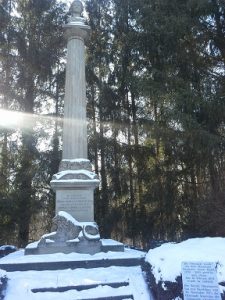
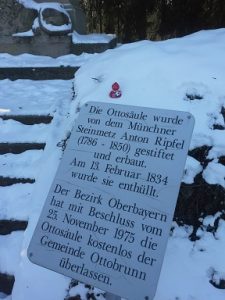
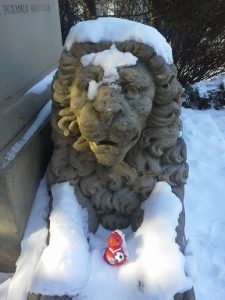
He came into a country where chaos, theft and piracy was abundant after the long liberation war against Turkey and where there was no public management or state organization. He brought a lot of money too from his farther. He learned the new Greek language, many of his romantic adviser only spoke antique Greek. Otto also introduced the “Bayerisches Reinheitsgebot” which regulates the ingredients of beer in Bavaria in Greece. Gustav Clauss who opened the popular vinery Achaia Claus (customers Otto von Bismarck, Franz Liszt, Onassis, Omar Sharif) was one of the men who came to Greece with King Otto. Otto allied with Russia against France an Brittain and had no heir and therefore had to retreat and return to Bavaria.
Most famous king of the Wittelsbacher (son of Max II. and Marie) however is King Ludwig II. (Otto Friedrich Wilhelm Ludwig) who was born in Nymphenburg Castle 1845. He died 1886 in the “Würmsee” (lake), later renamed “Starnberger See”.
It was probably him who turned the Bayerischer Defiliermarsch of Adolf Scherzer from 1850 (originating in Ingolstadt) into the iconic inofficial Bavarian Naional hymn and you can hear it „Auf der Wiesn“ (at the Oktoberfest) very often.
 There are several films about his life. Ludwig started to build the probably most famous and iconic castle of the whole world “Neuschwanstein” in 1869. It probably even served as a model for Disneys theme parks.
There are several films about his life. Ludwig started to build the probably most famous and iconic castle of the whole world “Neuschwanstein” in 1869. It probably even served as a model for Disneys theme parks.
The construction started 1869 and wasn’t finished just like many of the kings other projects. King Ludwig II. was very open for new technical achivements like steel construction which he deployed in Castle Neuschwanstein, the neighbouring “Marienbrücke” (steel pedestrian bridge with a splendid view over the castle) and roof windows in Castle “Herrenchiemsee”.
Sheila fought her way through the masses of People.
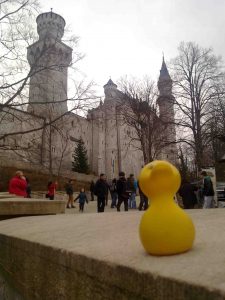
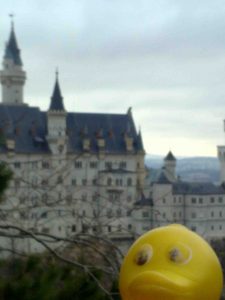
Sheila on the giddiness causing “Marienbrücke” with a splendid view over “Neuschwanstein”. As at many other bridges couples started to attach locks on the bridge.
Plansee
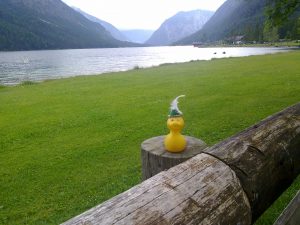 Ludwig II. also planed to built a Chinese Summer Palace at the Plansee, Tirol but never started that Project.
Ludwig II. also planed to built a Chinese Summer Palace at the Plansee, Tirol but never started that Project.
Sisi Schloß
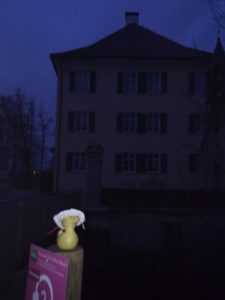 Famous cousin and friend of Ludwig II., iconic Wittelsbacher Princess and later “Empress Elisabeth of Austria” (Queen of Hungary), wife of Franz Joseph Habsburger emperor, as a child stayed in the “Sisi Schloss” (water dastle) in “Unterwittelsbach”, a hunting castle owned by her farther, popular “Herzog Max” (nickname “Zither-Maxl”). Herzog Max stemed from the Wittelsbacher side line “Pfalz-Birkenfeld-Gelnhausen” and as a virtuoso zither-player he turned the zither into the iconic bavarian instrument.
Famous cousin and friend of Ludwig II., iconic Wittelsbacher Princess and later “Empress Elisabeth of Austria” (Queen of Hungary), wife of Franz Joseph Habsburger emperor, as a child stayed in the “Sisi Schloss” (water dastle) in “Unterwittelsbach”, a hunting castle owned by her farther, popular “Herzog Max” (nickname “Zither-Maxl”). Herzog Max stemed from the Wittelsbacher side line “Pfalz-Birkenfeld-Gelnhausen” and as a virtuoso zither-player he turned the zither into the iconic bavarian instrument. 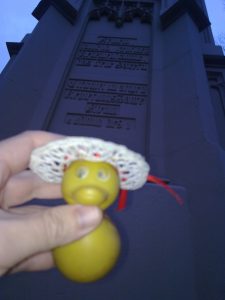 He was bewed-ded with “Ludovika Wilhelmine” of Bavaria daughter of King Maximilian I. and it was an arranged marriage after she was already in love with another man who later became king of Portugal (Don Miguel). Other then shown in the Sisi movies they say they didn’t love each other a lot although they had 10 children. While throwing her bridal Bouquet she maledicted the marriage:
He was bewed-ded with “Ludovika Wilhelmine” of Bavaria daughter of King Maximilian I. and it was an arranged marriage after she was already in love with another man who later became king of Portugal (Don Miguel). Other then shown in the Sisi movies they say they didn’t love each other a lot although they had 10 children. While throwing her bridal Bouquet she maledicted the marriage:
”Dieser Ehe und allem, was daraus hervorgeht, soll der Segen Gottes fehlen bis ans Ende”.
This marriage and anything which may arise there from shall lack gods blessing.
Max enjoyed travelling just like his daughter Sisi. Sisi as a girl used to dance for the money they throw in neighbouring inns of the castle while her popular father Max played the Zither. Later Sisi told a servant whom she showed the coins which she had kept as souvenir, that this was the only money she had ever earned by herselve.
s. Sissi films. Sissy was born 1837 in Munich in the Herzog-Max-Palais (the spot is seat of the Bavarian Central Bank today) was considered one of the most beautiful women of her time. Her vainness and Fitness was notorious as she kept her servants busy following her or getting her all kinds of cosmetics (like Wiener Schnitzel which she put on her face).
Sissy was born 1837 in Munich in the Herzog-Max-Palais (the spot is seat of the Bavarian Central Bank today) was considered one of the most beautiful women of her time. Her vainness and Fitness was notorious as she kept her servants busy following her or getting her all kinds of cosmetics (like Wiener Schnitzel which she put on her face).
She worked hard to keep her weight of 50 kg and wasp waist. She loved to travel, just like her father. Some say she pretended some of her sicknesses to be able to leave the court in Vienna to be able to travel.
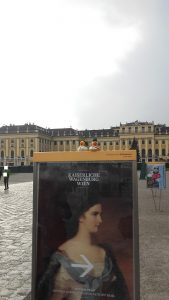
She was assassinated 1898 in Geneva, Switzerland by a anarchist and is interred in Vienna, Austria. Her son crown prince Rudolf comitted suicide in Mayerling 1889 and from then on Sisi only wore black clothes. While already beeing empress she spent her holidays in this Hotel at the Starnberger See where she was also able to meet Cousin Ludwig II. on the Roseninsel. Statues of both of them are in the Casino on the Roseninsel.
Kaiserin Elisabeth
And here is the Hotel Kaiserin Elisabeth (the Bayerischer Rundfunk produced a documentation about it), a splendid family owned Hotel with a Golf course with world class views. Although Sheila and I came in late for lunch, the friendly helpful staff still got us a excellent fish lunch and ice-cream for desert. A great place for celebrations. The room empress Sissi stayed in can still be rented and is kept in it’s original condition.

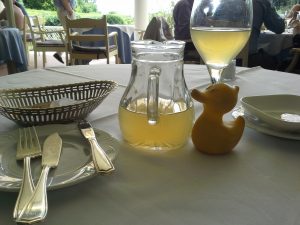
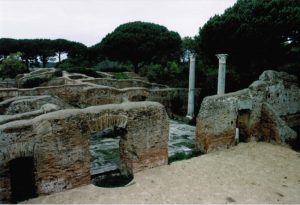 Another famous sister of Sissi was Marie Sophie Amalia who 1860 bravely under fire faught next to the soldiers of weak husband Francesco II. (house Bourbon) in the fortress Gaeta close to Napoli against Garibaldis (who formed the new state of Italy) troups. She also caused several scandals (I recently heard a documentaion on the radio), smoking in public, having a affair or swimming nacked in Ostia.
Another famous sister of Sissi was Marie Sophie Amalia who 1860 bravely under fire faught next to the soldiers of weak husband Francesco II. (house Bourbon) in the fortress Gaeta close to Napoli against Garibaldis (who formed the new state of Italy) troups. She also caused several scandals (I recently heard a documentaion on the radio), smoking in public, having a affair or swimming nacked in Ostia.
Linderhof: Cousin King Ludwig II. possessed one of the first telephones at that time and installed the first permanent electrical power plant with generators from Siemens at Castle “Linderhof” propelled by a steam engine 1878 and electrified the castle and the bizarre “Venusgrotte”, an artificial cave. The first commercial powerplant, for one customer only though. That was 4 years before Eddison invented? improved and marketed the light bulb and started a commercial plant. Ludwig II. used “Kohlebogenlampen” (coal-arch-lamps) which originated in England 1802, than here deployed by Siemens. Ludwig was inspired by the inventions presented at the world exhibition in Paris 1867. He also planed a funicular with a cabin in the shape of a peacock over the Alpsee at Hohenschwangau. Linderhof was the one castle which was built and finished 1870-1886) during Ludwig II.’s lifetime. It was his most favoured castle, away from the burdens of live.
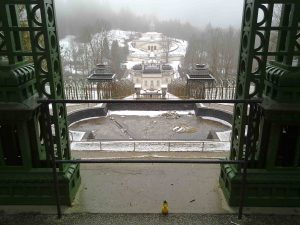
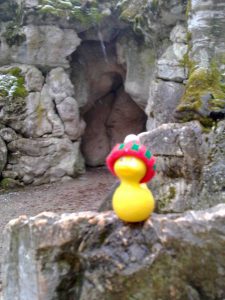
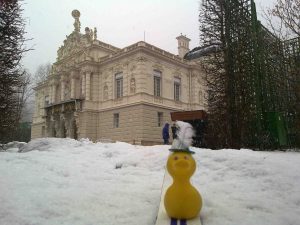
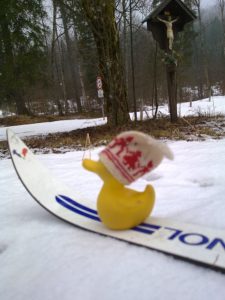 The neighbouring village Oberammergau organizes a cross-country-skiing race every year since more then 40 years for ambitious amateurs with a track which normally (if there is enough snow) also runs through the park of the Castle Linderhof. The “König Ludwig Lauf“. It is part of the Worldloppets. 1871 King Ludwig II. visited Oberammergau to see a special performance of the “Passion Play”. He liked it and gave every one of the main actors a silver spoon as reward. All except the one who played the character “Judas” who received only a tin spoon. More important than joining the foundation of the II. German Empire 1871 under Prussian Rule.
The neighbouring village Oberammergau organizes a cross-country-skiing race every year since more then 40 years for ambitious amateurs with a track which normally (if there is enough snow) also runs through the park of the Castle Linderhof. The “König Ludwig Lauf“. It is part of the Worldloppets. 1871 King Ludwig II. visited Oberammergau to see a special performance of the “Passion Play”. He liked it and gave every one of the main actors a silver spoon as reward. All except the one who played the character “Judas” who received only a tin spoon. More important than joining the foundation of the II. German Empire 1871 under Prussian Rule.
So Sheila thought she should bring her skis as no duck here has ever been fotographed on skis. Sheila went cross-country skiing in front of Castle Linderhof and took a look into the bizare “Venusgrotte” (artificial cave) which inside refers to a Opera of Richard Wagner (“Tannhäuser”), a friend and protegee of Ludwig II. Another good friend of Ludwig II. was Paul von Thurn und Taxis.
Herrenchiemsee
Linderhof
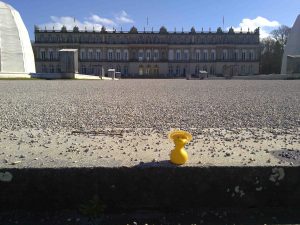 Ludwig II. Born 1845 admired the french king Louis XIV († 1715). a lot and used the Castle Versailles as a model for his castles, especially “Herrenchiemsee” on an Island in the biggest lake of Bavaria, the “Chiemsee”. He here even copied the “Mirror Hall” of Versaille but he built it a little bigger then the original. In contradiction to Versaille no roaring parties ever took place here, strange Ludwig II. built his castle for himselve. Taking pictures is no longer allowed in the castles. The building startet 1878. Ludwig II. only finished the central wing of the castle and couldn’t start building the planned 300 m wide wings at the sides of the castle. As a technic nerd King Ludwig installed or planed to install a central heating system and a big heated bath and as in serveral castles an automatic table elevator for his dining room. King Ludwig used to have dinner for one with imaginary guests, one of his special friends he invited for dinner was Louis XIV . The island “Herreninsel” is served by regular boat service from serveral harbours at the banks
Ludwig II. Born 1845 admired the french king Louis XIV († 1715). a lot and used the Castle Versailles as a model for his castles, especially “Herrenchiemsee” on an Island in the biggest lake of Bavaria, the “Chiemsee”. He here even copied the “Mirror Hall” of Versaille but he built it a little bigger then the original. In contradiction to Versaille no roaring parties ever took place here, strange Ludwig II. built his castle for himselve. Taking pictures is no longer allowed in the castles. The building startet 1878. Ludwig II. only finished the central wing of the castle and couldn’t start building the planned 300 m wide wings at the sides of the castle. As a technic nerd King Ludwig installed or planed to install a central heating system and a big heated bath and as in serveral castles an automatic table elevator for his dining room. King Ludwig used to have dinner for one with imaginary guests, one of his special friends he invited for dinner was Louis XIV . The island “Herreninsel” is served by regular boat service from serveral harbours at the banks 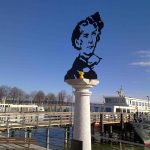 of the lake (“Prien” f.e.) as long as the weather allows the service all year long. The lake is situated picturesquely in front of the Bavarian Alps about 80 km east of Munich.
of the lake (“Prien” f.e.) as long as the weather allows the service all year long. The lake is situated picturesquely in front of the Bavarian Alps about 80 km east of Munich.
Neuschwanstein
Votivkapelle
Fairy-tale King Ludwig II. died mysteriously 1886 in the “Würmsee”, today called “Starnbergersee” after he was toppled, put under toplage by the government, arrested in castle “Neuschwanstein” an bared in castles Berg”. It’s not clear if it was murder, suicide or an accident. The place where he died in the lake is marked with a cross and on the shore of the lake not far away a memorial chapel was errected under the reign of his uncle “Prinzregent Leopold”, the “Votivkapelle” in the village of Berg, 10 years later.
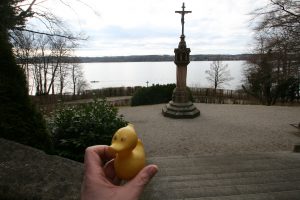
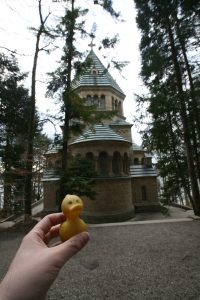
Fürstenried
King Ludwig II. while he was in office took good care for his mentally sick brother King Otto and completed castle “Fürstenried” to a place where Otto could live in peace and away from the public. Fürstenried served as a hunting castle during the times of Max Emanuel and Karl VII. Albrecht in the 18’th century but was severaly damaged in the Napoleon Wars and later as it was used as a military barrack and hospital until Ludwig bought it 1881. There is a hiking trail from the Starnberger See to Neuschwanstein. König Ludwig Wanderweg.
1886 after Ludwigs II. mysterical death Otto became formal King of Bavaria, but due to his mental illness he was unable to rule. Otto lived in castle Fürstenried until he died 1916. Castle “Fürstenried” has a spectacular still existing visual axis through a former still imaginable park towards the Munichs “Frauenkirche” (cathedral). As there are no high buildings in Munich’s south (not many high rise buildings in all of Munich) the two towers of the cathedral are very well visible far behind the tree avenue. Important to know is also, that the “Residenz” (Wittelbacher headquater) is directly behind it the cathedral. The tree avenue has been used and is still used as the last stage of the freeway 95 to Garmisch-Partenkirchen.
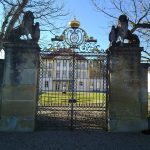
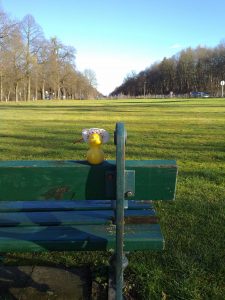
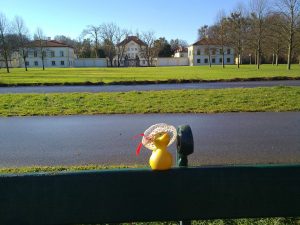
The castle was again used as military hospital during World War II and as a alternative location for studies by the Theological Faculty of the Luwig-Maximilians-University 1947-1949. Later cardinal Ratzinger (still alive) who became Pope Benedict XVI. studied here during that time.
The castle is still used by the bishopric München-Freising for the education of priests.
Because of the mental illness of King Otto I. his uncle Luitpold took over the ruling business, “Prinzregent Luitpold”. Luitpold completed the “Prinzregentenstraße” with the monument “Friedensengel” and the “Prinzregententheater” built 1900 – 1901.
Friedensengel
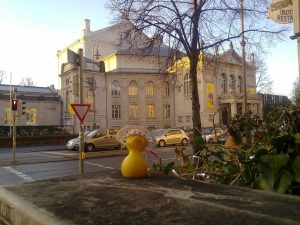
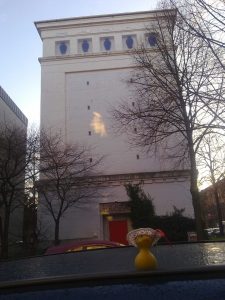
This slower march is dedicated to Prinzregent Luitpold. (Karl Schleth Galppmarsch)
Prinzregentenplatz
At the Prinzregentenstraße you can also find the “Kunstbunker” a WWII bunker which is now used for art exhibitions. Hitler had his Munich apartement here at the Prinzregentenplatz (today a Police Station) , later after his poorer times. Richard Marowitz of the US armee was able to take booty of Hitlers hat here in 1945.
and the Friedensengel.
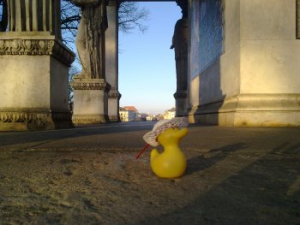
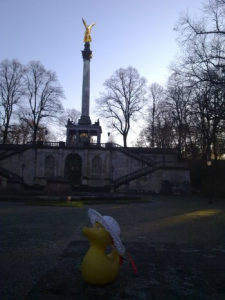
The “Friedensengel” appears in this music video.
It took Sheila a while and some efforts to find a statue of “Prinzregent Luitpold”, the leading character of the “Guade oide Zeit” (the good old time”). There used to be one in the cure garden in “Bad Reichenhall” but Sheila could not find it.
But here ist one in Munich:
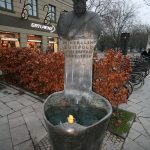 Prinzregent Luitpold “Brienner Str.” in Munich.
Prinzregent Luitpold “Brienner Str.” in Munich. 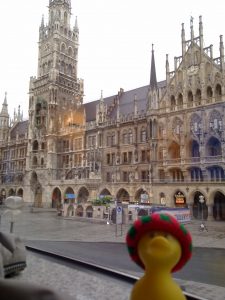 There is another one on the fasade of the new City hall in Munich at the Marienplatz where almost all important Wittelsbacher are commemorated with a statue.
There is another one on the fasade of the new City hall in Munich at the Marienplatz where almost all important Wittelsbacher are commemorated with a statue.
Cafe Luitpold
There is a splendid coffee shop next door, also a place for the rich and beautiful, “Cafe Luitpold” and artists. The Wittelsbacher always promoted art and Crown Prince Rupprecht during WW I helped, that Paul Klee (who with Kandisky founded the artist group “Blaue Reiter” in the coffee shop could do his military service in the royal airbase Schleißheim. (after Munich had lost other famous painters in the war like Franz Marc.
Flugwerft Schleißheim
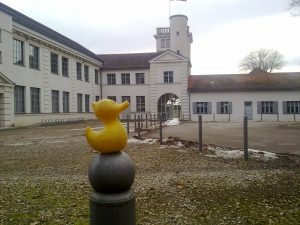
Flugwerft Schleißheim”, oldest still operating airfield in Germany and Museum.
1899 Prinzregent Luitpold rejected his admission to built a means of transport up on the „Zugspitze“ because he said there is no demand for such a transport. 500.000 People today visit every year.
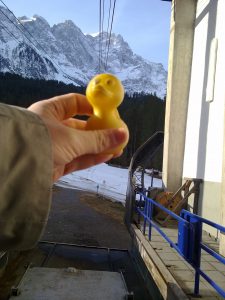
„Mercyfull“ Luitpold also refused an appeal for clemency of „Räuber Kneißl“.
Schloss Wildenwart
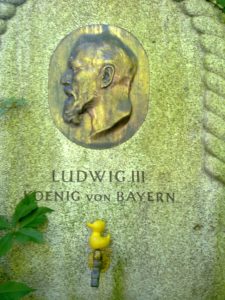 Which brings us to the so far last king and ruler of Bavaria of the Wittelsbacher dynasty, “König Ludwig III.”, son of “Prinzregent Luitpold”. A march has been dedicated to that king.König Ludwig III. von Bayern – Marsch He is also known by his nickname “Millibauer” (dairy farmer) as he had a passion for farming. He liked to spend time with common joe’s. Ludwig III. was king from 1913 to November 1918 when he was toppled in the “Novemberrevolution” led by social democrat “Kurt Eisner“. Ludwig III. learned about the revolution while he was on one of his formless, daily walks through the “Englischer Garten” when a passer-by told him: “Majestät, genga S’ hoam, Revolution is!“. (majesty, go home, it’s revolution) Ludwig III. fled to private “Castle Wildenwart” and than on to “Castle Anif” close to Salzburg where he accepted that he had lost the support of the army (the officers had been arrested by the revolutionaries) and the people and common soldiers of Bavaria after bloody WW I. Ludwig released the army and his ministers from their oath’s of allegiance. This de facto ended 738 years of reing of the Wittelsbacher dynasty in Bavaria. However Ludwig III. did not formally renounce the title King.
Which brings us to the so far last king and ruler of Bavaria of the Wittelsbacher dynasty, “König Ludwig III.”, son of “Prinzregent Luitpold”. A march has been dedicated to that king.König Ludwig III. von Bayern – Marsch He is also known by his nickname “Millibauer” (dairy farmer) as he had a passion for farming. He liked to spend time with common joe’s. Ludwig III. was king from 1913 to November 1918 when he was toppled in the “Novemberrevolution” led by social democrat “Kurt Eisner“. Ludwig III. learned about the revolution while he was on one of his formless, daily walks through the “Englischer Garten” when a passer-by told him: “Majestät, genga S’ hoam, Revolution is!“. (majesty, go home, it’s revolution) Ludwig III. fled to private “Castle Wildenwart” and than on to “Castle Anif” close to Salzburg where he accepted that he had lost the support of the army (the officers had been arrested by the revolutionaries) and the people and common soldiers of Bavaria after bloody WW I. Ludwig released the army and his ministers from their oath’s of allegiance. This de facto ended 738 years of reing of the Wittelsbacher dynasty in Bavaria. However Ludwig III. did not formally renounce the title King.
Leutstettten
Wildenwart
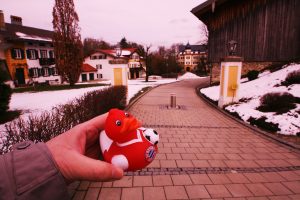
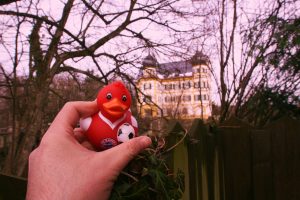
Uli (Sheila is in Asia) at “Castle Wildenwart“, one of the last home of Ludwig III. and now family home of some of the Wittelsbacher (who still possess and use the title: Duke and still are royal highnesses).
Ludwig III. also lived in Castle Leutstetten and he here built up a agricultural model farm. As I saw a film on TV yesterday about Royal Highness and Wittelsbacher Princess Auguste von Bayern on TV and her zoological disertation about the intelligence, behaviour and communication of tower choughs I had to visit Castle Leutstetten immediatly. Sheila likes the Alpine Choughs a lot as they show a very cute and intelligent behavior and they also enjoy to be fed by mountain hikers showing their artistic flight in front of mounain huts and restaurants. Sheila also thanks Auguste for taking good care of the chough who fell out of the nest and broke one wing. Sheila hates those heartless scientists and filmakers who don’t help animals in real bad conditions for professional reasons even if it would be easy and provided a good story. Castle Leutstetten was bought by later king Ludwig III. 1875 and Prince Luitpold von Bayern and Auguste live here.
And there is a memorial plate for Ludwig III. at a fountain too, I have been looking for a memorial for a long time.
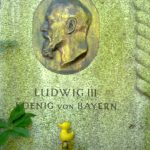
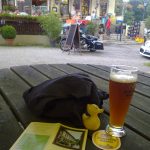
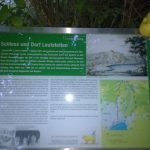
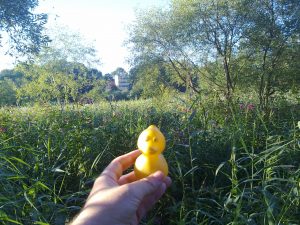
And there is a popular restaurant and beer garden too, Schlossgaststätte Leutstetten where they serve the good König Ludwig Dunkel Weißbier, brewed by Luitpolt in Kaltenberg. The density of Porsches and Harleys is high here, close to the Starnberger See.
To get a Picture of the Castle which is hidden behind trees at the northern, eastern and western side Sheila and I had to find a way into a mosquito invested swamp to get a decent picture.
Crown Prince Rupprecht (Rupprecht von Bayern) died here in Leutstetten 1955. He was the last Wittelsbacher, who received a big formal state funeral with a big participation of the People of Bavaria. He was a important commander fighting in WWI. and after Germany had lost WWI. and there had been plans to indict him for war crimes (Treaty of Versailles) he used the false Name Alfred Landsberg to travel from Brussels to Germany, Berchdesgaden. The lawsuit never took place though. As he opposed the Nazis, he had to hide during WWII. but this wife and children were arrested in concentration camps Dachau and later Flossenbürg.
Kronprinz Rupprecht is commemorated with a fountain (1961) on the east side of the Residenz in Munich.
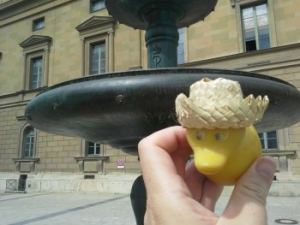
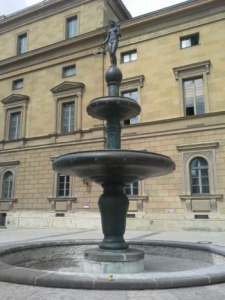
Actual leader of the dynasty is “Franz Herzog von Bayern, Franken und in Schwaben, Pfalzgraf bei Rhein” (still inofficially politely called Royal Highness). The bachelor lives in a wing of “Castle Nymphenburg”. Next one in line is his brother “Max Emanuel Herzog in Bayern” who lives with his familiy in Castle Wildenwart.As Franz and Max Emanuel are also decendants of a femal line of the “Jakobiten” (who allow female heritage of throns and titles) and by that of the british Stuarts and since the Wittelsbacher never formally renounced the title “King of Bavaria” there is a small chance that we might see a United Kingdom of Scottland, England, Irland, France and Bavaria in the future. Fans of such ideas exist in Scottland and in Bavaria. f.e. “Guglmänner“. Franz, a successor of James II. respectively Jacob II, due to that carries the Jakobitish title “Francis II, King of England, Scottland, Irland and France”. James II. Also known as Duke of York. He took over Nieuw Amsterdam 1667 and the name was changed to New York. After the Peaceful Wittelsbacher Ferdinand Maria had missed the chance to buy it and to name it New Munich.
Another member of the family from the Adalbertische Line (Adalbert 4’th son of king Ludwig I. of Bavaria) is brand ambassador for BMW Leopold Prinz von Bavaria “Prinz Poldi”. The former race car driver was member of the “Trio Infernale”(Stuck, Quester, Poldi) who played other racer tricks. Here is a interview on the roof of “Hotel Bayerischer Hof“.
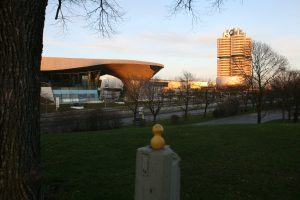

Poldi was dating actress Uschi Glas in his young days. “Sie war sehr süß”. (She was very sweet)
Munich Uschi
Poldi’s and Princess Ursulas of Bavaria daughter “Princess Felipa” married 2012 in the “Wieskirche” and the wedding party took place in castle Hohenschwangau. Poldi’s statement at the wedding “Ich habe damals als erster der Wittelsbacher eine bürgerliche Frau geheiratet.” (I was the first Wittelsbacher to marry a commoner) must be impeached however, thinking about Agnes Bernauer and Prinz Carls wife Marie-Anne-Sophie Petin. Of course 800 years is a long time and of course a lot of beer, probably good Wittelsbacher beer is drunken at weddings.
Wittelsbacherbrunnen
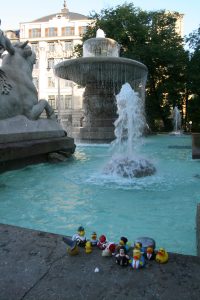 1893-95 the City of Munich built the Wittelsbacherbrunnen.
1893-95 the City of Munich built the Wittelsbacherbrunnen.
(to be continued)
Well, Sheila knew it, now with the Brexit Scottland and Irland might need a new king, the Wittelsbacher got serveral to offer.
Credit: Maps Icons Collection, https://mapicons.mapsmarker.com
5,074 total views, 6 views today